#1930s are a hard time period to write (and research) for the record
Explore tagged Tumblr posts
Text
AU where Bobby got super sick his Freshman year after he’d already been accepted into the rowing team, but before his first race. And he had to get surgery and had some complications, because of course he does, and he’s forced to drop out that semester and quit the rowing team because he’s in the hospital for so long. He comes back the next semester but isn’t able to rejoin the rowing team because they’re mid season.
The next year he’s so freaking determined to make the team and he does. Then the year after that, technically his junior year, he makes Varsity. Then there’s the issues and he gets kicked off, but brought back a several weeks into his “senior” year to cox the JV crew and they win gold at the Olympics. He’s left feeling super accomplished and everyone is super excited for him because like like what a way to go out for your last year. But sike, he’s actually gotta stick around for another semester because he’s behind on some credits he missed his freshman year, not that anyone on the crew knows that. And he would love to stay with his boys for another year, even if he’s gotta stay for another full year and even if they lose every race (which Bobby knows for a fact they won’t), it’ll be worth it.
He’s a pre-law student so he looks through the every handbook and rulebook for athletics and academics and he discovers that technically he’s still eligible since he didn’t even get to compete in a single race his freshman year. So he gathers his extensive medical records and stuff and goes to Ulbrickson. He keeps it a secret because he doesn’t want to get the other boys’ hopes up, and the other coaches have to agree to it or something.
TLDR; Bobby gets redshirted his Freshman year due to medical reasons (ie dropped out of school and rowing for his first semester) and finds a way to get approved for a “fifth” year
#1930s are a hard time period to write (and research) for the record#like idk how collegiate rules worked in the 1930s for this kind of stuff lmao#the boys in the boat#bobby moch#boys in the boat#boys n boats#bobby and his boys#bobby moch is stubborn af#Fic ideas#yall can always write any of these things I come up with for the record like please do#and tag me so I can read them becuase I WANT TO READ THEM 😭#botched appendectomy#<- my tag for anything related to Bobby’s medical history#someone write this please 🙏
30 notes
·
View notes
Text
Apologies for how long this is about to be
I am currently in college getting a dual minor in History and Gender and Women’s studies, and that future degree is calling to me telling me I need to talk about the historical context of Malevolent and how the time period plays a bigger role in the story than most people think about specifically when it comes to diversity in minority characters (Will not be talking about season 5 because that is whole other can of Cassandra’s history brain worms).
Real quick, this is honestly just word vomit, truly just me rambling, I don’t want to start shit these are just my observations as someone who is currently studying related topics. Sorry for the hot takes ig.
adding cut here before I get into it lol
A thing I love about Malevolent is that Harlan Guthrie made an effort to do research and be as historically accurate as he could while telling a supernatural story. One of the things anyone will quickly learn when researching any history, is that most of the time life was not fun unless you were a straight, white, upper class, cisgender man. Even by the 1930's America was extremely segregated, women had the right to vote but not much else, not to mention homosexuality and gender transition was criminalized until around 1964.
I have been seeing a lot of talk about Faroeverse and people saying it’s just the same story but yuri and guys… Malevolent would not be the same story at all if Arthur was a woman. As I said before, women barely had rights, they also had completely different lives. Women in the 1930’s were still working incredibly hard for their rights. Not to mention that the female experience in any time period is just so much different from that of the male, I could write a whole other rant just about the differences there but we’ll save that for another day. Swapping Arthur’s gender and trying to keep Malevolent historically accurate changes e v e r y t h i n g. Faroe/Bella/whatever you wanna call her, would not be able to be a PI, she would not be able to buy a gun and a new identity, she would not be able to hitchhike with the confidence Arthur did, she would not be able to enter the freemason’s building, and so much more. If Malevolent is about a woman in the 1930’s it is a very different story.
Only going to briefly touch on race because anyone can picture Arthur however they want and tbh this is the internet, anything I say someone will have a problem with… Just like don’t complain that majority of people see Arthur as a white man, because unfortunatly… historically speaking if he wasn’t a white man he would almost certainly not have made it out of Arkham. Also I don’t think that Harlan (you know a white man from Canada) wants to write about racism in 1930’s America, and honestly I think he’s not in the wrong for that.
My final thing is I feel it is unfair to point at Malevolent and say it’s “queerbait” or be mad that there are not “canonically queer characters”. The 1930’s were not safe for queer people like at all. A character will not just go up to another and say “I am gay and in love with you” because if someone in the 1930’s did that there would be a non-zero possibility of them being beaten, lynched, or even burned alive for it. Malevolent is not queerbaiting, because also it was not intentionally written to be queer. Does it have like an insane amount of subtext and queer coding similar to media from the time? Absolutely. But it is just not queerbait guys, Harlan is not teasing us with a “Will they won’t they” he has gone on record to say they won’t, but that we all are free to enjoy it however we want.
If you read all of this… I’m sorry. Hope you enjoyed. Again I say I am not here to start shit, these are just my thoughts. Gonna go write an essay about Malevolent for fun now, if I publish that one it will be much more refined and professional than this mess lol.
#Spent 3 hours writing this#Cassandra is going a little crazy sorry y'all#if any of these are particularly hot takes sorry ig#malevolent#malevolent podcast#arthur lester#john malevolent#faroeverse#cassandra’s ramblings#ramblings#so many thoughts#so many words#im so normal#guys my girlfriend left me for two and a half hours after I started this and came back and I wasn't done#im normal i promise
39 notes
·
View notes
Note
i don’t have a number for you, so this is an open invitation for you to pick the number you most want to answer and answer that :)
You say that as if I read through ask game lists before reblogging them lol. Okay uhhhhhhhhhh
11. what’s something neat you’ve learned while doing research for something you were writing? also, how much do you worry about doing research in general?
I got to 11 and immediately knew I had to answer this. Okay so the coolest thing I've learned doing research for fic unrelated to YR is the Cŵn Annwn. They're this sorta spirit dog in Welsh mythology (I was doing research for a spn fic I never published) and they're usually little white dogs with red ears seen as a foretelling of death. They're from Annwn, the otherworld, and a part of the Wild Hunt. They also may be somewhat related to Gabriel's Hounds, which is an English myth. I have to physically restrain myself from adding this to like everything I write, I love these funky little dudes so much. I also made up the world's worst, most obscure joke after learning the pronunciation that requires like so much random knowledge to understand but I find it hilarious. Here it is: What would Blackbeard's ship be called if he was from Welsh mythology? The Cŵn Annwn's Revenge
Okay and now that no one's laughing and I look ridiculous, here's the coolest (sorta) piece I've picked up doing YR fic.
So during the writing of Dear Titanic, I was on a mission to have things about the ship super historically accurate and I spent like 40 minutes tracking ship records and stuff trying to figure out if any of the musicians on board personally knew the Captain. The consensus was I don't fucking know, I can't find anything. I also learned that there's like no records of the actual songs they played which was very annoying, and then I had a hard time tracking down popular music in the 1900s-1910s cause everything was from either the 1870s or 1930s and that was SO annoying. So that was fun! I learned a LOT about the Titanic writing it.
As for the second question, do I worry about doing research? My fellow humans of the tumblr, you are looking at a man that read the Prose Edda (Norse mythology), yes the actual Prose Edda not fun little compilations like Neil Gaiman's Norse Myths (though I did read that too, he did good with it), for fun in high school. You are looking at a man that spent the better portion of sophomore year reading the library's physics books during 5th/6th/7th period every day trying to figure out time travel (unsuccessful, entropy is a bitch, but I have ideas about breaking light barriers with neutrinos and deuterium). You are looking at a man who found Old Latin texts on alchemy and tried to translate them for a fic (unsuccessful, Latin is a bitch), and when getting into actual fic communities way back at 13 years old, would make their Harry Potter stories canon compliant by going through the books with post-its marking off scenes where the characters I was writing about weren't around so I wasn't breaking canon. In other words, no I don't worry about doing research at all. I worry about going overboard with it. And thankfully, I have chilled out a bit on making things canon compliant. AUs are so much fun.
Talk to me about my funky little words
#asks#i just vibrate on another frequency about research#you give me an interesting subject and i WILL learn everything i can about it
4 notes
·
View notes
Text
Welsh LGBT+ and Black History?
February was LGBT+ History Month in the UK and Black History Month in the US. Yes, both the shortest month. Black History Month in the UK is October, as is LGBT History Month in the US. That these two coincide gives an opportunity to uncover more histories of LGBT+ People of Colour.
There are certainly many Queer People of Colour to be celebrated, as my reblogs contain LGBT+ people celebrated in Black History Month. But when so many are American - the blogs, posts and articles by Americans - where is the UK history of Queer People of Colour, let alone a history of Queer People of Colour in Wales? Where was their history in UK’s LGBT+ History Month? What coinciding LGBT+ and Black History Months has highlighted is we need to uncover the history of Queer People of Colour in our whole history, and decolonising our history has to be ongoing, not just celebrating these figures once or twice a year.
In the historiography (the literature of Welsh LGBT+ History) there is practically nothing, no history of Queer People of Colour in or from Wales. Kirsti Bohata writes on postcolonial theory and Queer themes in literature - in her chapter in Queer Wales, the presence of queer women is explored in the literature of Wales, as well as on the borders of Wales (gendered borders and borders of Nationhood, which are apparent in Welsh literature, such as Margiad Evans’), where the are negative images of Blackness. In the history, Cliff Gordon is said to have ‘discovered’ Shirley Bassey, when he cast a musical on the life of Al Jolson. These are very tenuous links between Welsh LGBT+ History and Welsh Black history, the literature on which is itself also sparse.
To search for any history of Queer People of Colour in Wales, I first looked through the Fingerprint and Photographic Registers at Glamorgan Archives. Glamorgan Archives have already posted some examples of LGBT+ people arrested in these records - men arrested for ‘buggery’ and ‘gross indecency,’ including of Abdulla Taslameder, and Martha Alice Hodson, arrested for committing crimes while ‘masquerading as a man.’ Crime records have more information on working class people, rather than those who already make up LGBT+ History, and when there is little information on the people arrested, the photographs give more indication on where People of Colour were arrested, rather than just going by their name.
Immigrants’ names might be more apparent, but this of course would not be true for all. These records do note when individuals have been reported, such as with ‘Louis Perlin,’ arrested for ‘Gross indecency with male person’ on the 11th of January, 1910 and discharged by ‘Expelled.’ See previously linked blog post for images. Though his name is written as Louis Perlin here, in the format of the registers, it should be Perlin Louis. Perlin as a first name can be Jewish, or German. Confusion over names in the records (with names of immigrants) would not be surprising - Louis Perlin as a name could be again European (Eastern European, German, French) or American.
John Gevas was arrested on the 16th of April, 1912 for ‘Buggary attempted’ and was in the Assizes on the same date and on the 11th of July, 1912. He was sentenced to 12 months of hard labour and ‘recommended for expulsion’ - he was expelled to Greece on the 13th of May, 1913.


(Glamorgan Archives, DCONC/3/2/3, Fingerprint and Photographic Register, 1910-1914)
Immigrants, sailors, and others are arrested in the records, with large numbers of arrests of People of Colour in places. More than once there are examples of groups of Black men or groups of Asian men arrested together, and a handful of times there are all, or mostly, arrested for ‘Riot.’ i.e.

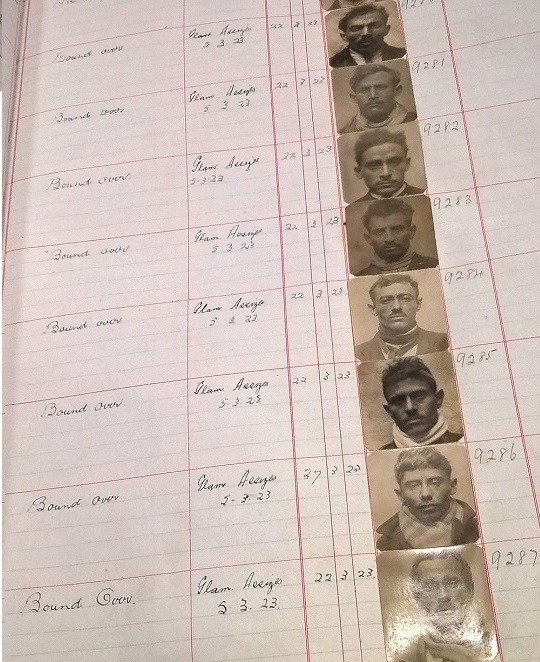
These are 8 men arrested for Riot on the 7th of February, 1923 (Abdul Norfaid or Kaled Salem; Hassan Kaleb/Kalea, Ali Hassan or Hassan Tabli; Kaid Saleh or Kail? Sala; Ali Kaidar or Ali Abdul; Hassen Ben Hassen; Abdul Rahman Ottman or Abdul Rahman Ossman; Mohamed Bey; Ahmed Raguch.)
(Glamorgan Archives, DCONC/3/2/6)
This history itself absolutely need to be looked at, as does the criminalisation of people for their sexuality. This is a part of Wales’ history, if not always the populations in Wales, then how Wales was (or is) complicit in the criminalisation of individuals for their sexuality and/or for their race.
Here are Queer People of Colour arrested in Wales who are in the Fingerprint and Photographic Registers at Glamorgan Archives:

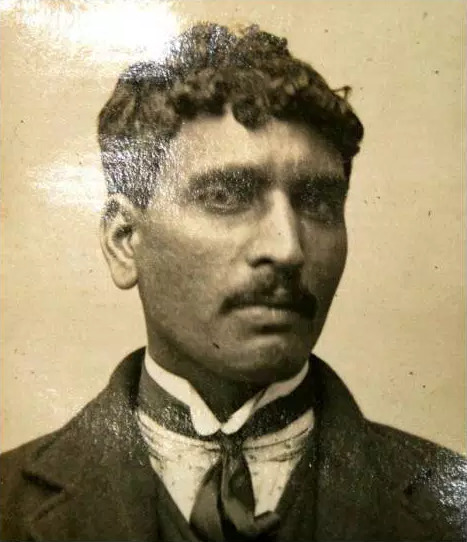
Abdulla Taslameder, also written as Abdulla Talameden, was arrested, or finger printed, on the 15th of August, 1918, for ‘Buggery,’ with no previous record found? He was sentenced, on the 6th of November, 1918, at Glamorgan Assizes, to 12 months of hard labour. An obvious issue arises looking at these records of his name being written differently in, which is an issue with the reading of the handwriting, which mostly looks like Taslameder, but there can also be the issue of the people writing their names. I have not yet found more about Abdulla Taslameder.

(Images via Glamorgan Archives blog, Queering Glamorgan, & Glamorgan Archives, DCONC/3/2/4)
On the 3rd of September, 1924, Andrew Ward and Ahmed Naser were arrested for Attempting ‘Buggery (Gross Indecency)’ and both were sentenced to 6 weeks of Hard Labour on the 11th of November at Glamorgan Assizes. Certainly they were arrested together and receiving the same sentence suggests it was a consensual act they ‘attempted’ and were punished for.


(Glamorgan Archives, DCONC/3/2/6)
What I’ve most recently found: Abdul Nagi was arrested also for ‘Buggery’ on the 20th of March 1930 and at Glamorgan Assizes on the 22nd of June was discharged. (Also in this record is that of Mohamed Shirrih, arrested for landing in the UK without permission of Immigration Officer – Deportation is recommended, presumably after first serving his sentence of 21 days of Hard Labour at Police Court.

(Glamorgan Archives DCONC/3/2/7 )
This is the history of Queer People of Colour in Wales that I have found so far - there is also an issue of more recent archives cannot be accessed (and should not be explicitly shared to possibly out anybody, of course). This is just a start to uncovering this history, as there is so much more LGBT+ history as a whole to uncover, and the histories of People of Colour need to be told in Wales so much more than they currently are. This blog post however has hopefully shown that the records of this history do exist to be researched in future - in a futute decolonised history of Wales.
If you know anything more about the history of Queer People of Colour in Wales, feel free to correct me or contact me!
Quick notes:
I have used the term ‘Queer People of Colour’ as this is useful in history for people whose specific sexuality we do not know, as well as where they were from in this case.
There are many more records I need to look at to search for more.
Images have been cropped and slightly enhanced to fit this blog and be more readable - you can contact me for the originals and to ask about the rest of my research! (Or suggest what more I could post about!)
You can support me at Ko-Fi, if you so wish!
Sources:
Glamorgan Archives, Fingerprint and Photographic Registers, DCONC/3/2/1-7 - used: DCONC/3/2/3-7, 1910-1933)
Glamorgan Archives LGBT blog post.
Norena Shopland, Daryl Leeworthy, ‘Queering Glamorgan,’ Glamorgan Archives.
Further Reading:
Yasmin Begum, ‘An independent Wales must undo the darkness of white supremacy’, Planet, 2018. (Yasmin Begum, and others, have written on the decolonisation of Wales.)
Kirsti Bohata in Huw Osborne ed. Queer Wales: The History, Culture and Politics of Queer Life in Wales, 2016 / other writing by Kirsti Bohata.
William Cross, The Abergavenny Witch Hunt: An Account of the Prosecution of Over Twenty Homosexuals in a Small Welsh Town in 1942, 2014. (Includes information on arrest of Cliff Gordon, as well as on LGBT arrests in the period.)
Norena Shopland, Forbidden Lives: Lesbian, Gay, Bisexual and Transgender Stories from Wales, 2017. (More on Cliff Gordon and many, many others.)
#welsh history#queer history#lgbt history#lgbt history month#black history month#black history#queer people of colour#m#by m#glamorgan archives#archives#links#queer welsh history#queer black history
3 notes
·
View notes
Text
Ragtime King

Overview
Ragtime Kings
The Ragtime King
Ragtime King Banjo
Supertone Banjo Ragtime King
King Of Ragtime Scott Joplin
This auction is for a real vintage USA made 1920’s or older Sears Supertone 5 string banjo, model 407, “Ragtime King”, 22 frets, 30 brackets, made by Lange. Condition is good for the nearly 100 years old that it is! No serious problems, sounds good, pretty loud! The metal parts are all tarnished and/or have minor surface rust from age.
In 1974, the academy award-winning film The Sting brought back the music of Scott Joplin, a black ragtime composer who died in 1917. Led by The Entertainer, one of the most popular pieces of the mid-1970s, a revival of his music resulted in events unprecedented in American musical history. Never before had any composer's music been so acclaimed by both the popular and classical music worlds. While reaching a 'Top Ten' position in the pop charts, Joplin's music was also being performed in classical recitals and setting new heights for sales of classical records. His opera Treemonisha was performed both in opera houses and on Broadway. Destined to be the definitive work on the man and his music, King of Ragtime is written by Edward A. Berlin. A renowned authority on Joplin and the author of the acclaimed and widely cited Ragtime: A Musical and Cultural History, Berlin redefines the Scott Joplin biography. Using the tools of a trained musicologist, he has uncovered a vast amount of new information about Joplin. His biography truly documents the story of the composer, replacing the myths and unsupported anecdotes of previous histories. He shows how Joplin's opera Treemonisha was a tribute to the woman he loved, a woman other biographers never even mentioned. Berlin also reveals that Joplin was an associate of Irving Berlin, and that he accused Berlin of stealing his music to compose Alexander's Ragtime Band in 1911. Berlin paints a vivid picture of the ragtime years, placing Scott Joplin's story in its historical context. The composer emerges as a representative of the first post-Civil War generation of African Americans, of the men and women who found in the world of entertainment a way out of poverty and lowly social status. King of Ragtime recreates the excitement of these pioneers, who dreamed of greatness as they sought to expand the limits society placed upon their race.
Image Credit: The “Scott Joplin 1911, The King of Ragtime Composers” portrait featured in this post came from NYPL’s Schomburg Center for Research in Black Culture, via the following Black History Month post: Slices of the Tenderloin #3: Scott Joplin. However you enjoy it, whether by playing it yourself on your instrument of choice or listening to others perform it, be sure to crank up.
Destined to be the definitive work on the man and his music, King of Ragtime is written by Edward A. A renowned authority on Joplin and the author of the acclaimed and widely cited Ragtime: A Musical and Cultural History, Berlin redefines the Scott Joplin biography. Using the tools of a trained musicologist, he has uncovered a vast.
Origins of Ragtime Music. Ragtime developed in African American communities throughout the.
Henry King, Director: The Song of Bernadette. For more than three decades, Henry King was the most versatile and reliable (not to mention hard-working) contract director on the 20th Century-Fox lot. His tenure lasted from 1930 to 1961, spanning most of Hollywood's 'golden' era. King was renowned as a specialist in literary adaptations (A Bell for Adano (1945), The Sun Also Rises (1957)).
The following book review by Jeffrey Chappell appeared in Piano & Keyboard Magazine, November/December 1994 issue.
Scott Joplin was a quiet, serious man who composed some of the liveliest, happiest music ever written. The unprecedented standard of excellence that he set and maintained earned ragtime world-wide renown. After the publication of “Maple Leaf Rag” he became known for the rest of his life as “The King of Ragtime.”
Ragtime fell into obscurity with the advent of World War I and with new developments in jazz forms. Its revival commenced in the 1940’s and gathered a momentum that peaked in the 1970’s, establishing its solid place in the repertoire. Contributing to this momentum was the 1950 publication of Rudi Blesh and Harriet Janis’ book, “They All Played Ragtime.” This was the first biography of Joplin, and was accepted as the definitive text on its subject.
In his preface to “King of Ragtime: Scott Joplin and His Era”, author Edward A. Logo design inspiration. Berlin makes clear the necessity of producing a new biography of Joplin. He honors the accomplishments of Blesh and Janis but points out that they were untrained in formal historical research. Much has been added to what was known about Joplin since their book appeared, but Berlin’s own investigations have yielded a significant wealth of new material. As such, “King of Ragtime” represents the best available current knowledge of this subject.
Some know Joplin only as the composer of “The Entertainer” and “Maple Leaf Rag”; they may even have heard his opera “Treemonisha.” These readers will be fascinated to learn about Irving Berlin’s alleged plagiarism of a tune from “Treemonisha” in his “Alexander’s Ragtime Band”; about Joplin’s first opera, “A Guest of Honor”; and about the origin of the terms “ragtime” and “Tin Pan Alley.” The chapter called “The Maple Leaf Rag, 1899-1900” will engross them with its step-by-step recounting of the creation, publication, and sensational reception of Joplin’s signature piece. They may be surprised to find that, in spite of the advanced level of difficulty of his piano pieces, Joplin himself was not always highly regarded as a pianist.
Ragtime Kings
The specialists will be richly rewarded as well. The origins of titles of pieces are ascertained; attributions of collaborative compositions are sorted out; and the chapter called “Freddie, 1904” tells of the existence of a previously unknown second wife. An entire page is devoted to the conflicting information about Joplin’s date and place of birth. Minute details of all kinds are provided, from the price of admission to a Fancy Dress Calico Ball in Sedalia, Missouri in 1898 to the address of Barron Wilkins’ older brother’s cabaret in Harlem in 1914.
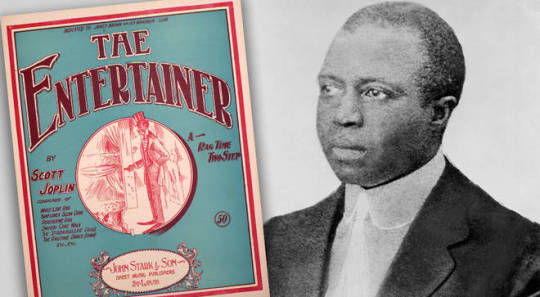
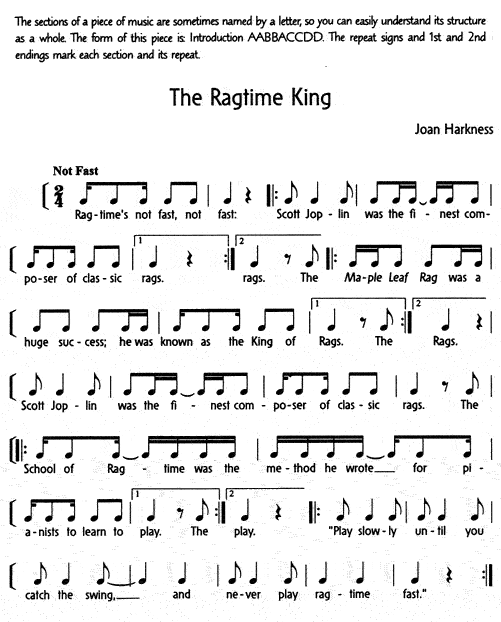
Enhancing the author’s clear writing style and organization are numerous illustrations, including photographs of Joplin and other ragtime writers, street maps of places that he lived, musical examples, and newspaper advertisements. These appear throughout the book as their subject is mentioned in the text, which is satisfyingly convenient for the reader.
All but one of the musical examples were typeset for the book. The exception is a photocopy of one page of the printed score of “Treemonisha”, and it is startling. To indicate the sound of women crying, Joplin invented a graphic notation that one would expect of avant-garde composers decades later.
The one known existing letter written by Joplin, an application for copyright for “A Guest of Honor,” is among the illustrations in the book. As interesting as it is to see his actual handwriting, one would wish that a page or two of his music manuscript had been shown. The author relates hearsay reports of a trunk of manuscripts being lost during the “A Guest of Honor” tour; and in his final chapter traces the hair-raising saga of the manuscripts left by Joplin after his death as they shifted hands again and again before being lost. But is every one of them lost? Where are the ones that he sold to publishers? Do any exist in the Library of Congress? The author does not say.
The book also has a sub-text which appears periodically as inserts in a typeface different from that of the main text. This provides background information about side issues such as prostitution in Sedalia, minstrelsy, and theater segregation. One ongoing series compares passages in Joplin’s piano rags to nearly-identical passages in the works of his imitators.
Filezilla server service. In the main text, the author finds that Joplin himself recycled some musical material. Analysis shows that “The Cascades,” “Gladiolus Rag,” “Leola,” and “Sugar Cane” were based on the “Maple Leaf Rag” model. In each case, however, new elements were developed, giving every rag its own appealing identity.
Berlin’s methods of detection and deduction are impressive: no statement or source goes without rigorous cross-referencing and confirmation. Previously accepted “facts” are brought into question and reinterpreted. In his quest to present all the available information, the author at times produces material worthy of a reference book. An early chapter describes Sedalia, Missouri in 1883 as “a good-sized, thriving town.” The ensuing paragraph lists the exact number of public schools, private schools, churches, secret and benevolent societies, paramilitary organizations, newspapers, banks and loan associations, and saloons; as well as the number, names, and racial makeup of baseball teams that formed later on. This is much more than most people would ever want to know about Sedalia, Missouri. Curiously, the other main Joplin residences, St. Louis and New York, are not afforded the same exhaustive treatment.
The Ragtime King
As painstakingly complete as is this volume of research, one finishes the book feeling strangely out of touch with Joplin’s interior life. We know his addresses and what pieces he composed when he lived at each of them with some degree of certainty. But his attitudes about life and his own experience of living it can only be deduced from what others said about him. This is no fault of the author: there are no known surviving diaries or personal correspondence. Joplin’s own words occupy a total of half a page in this book, and most of those are excerpts from his music instruction pamphlet, “School of Ragtime.”
Ragtime King Banjo
Blesh’s writings provided earthier, if perhaps apocryphal, anecdotes. He relates that a friend of Joplin complained at lunch that having to wait for a phone call allowed his fried eggs to get cold. Joplin said, “Look, Sam, if they’re good hot, they’re good cold.” This shows a man with a sense of humor as well as a sense of practicality.
From other reports we can tell that Joplin had a reticent manner. He spoke seldom and softly, but with a refined pronunciation and vocabulary that impressed those whom he met. He was regarded as a kind, pleasant, modest, and inspiring man. Nonetheless, he knew that what he produced was of excellent quality, and in an enterprising way sought the acceptance that he believed was deserved by him and his music.
The excerpts from “School of Ragtime” present Joplin’s defence of ragtime as a music with staying power and high class. He responds to the scurrilous perception of ragtime as being light and trashy by distinguishing it from lesser kinds of music, and by asserting that genuine ragtime was endorsed by cultured musicians. He goes on to admonish players of ragtime to be scrupulously exact with rhythm and tempo when playing “Joplin ragtime.”
Supertone Banjo Ragtime King
This shows a man who was meticulous about his work, who knew how good he was at it, and who took pride in it. It also shows how he struggled to gain respect. Joplin met with opposition to his chosen art form throughout his life. The fact that Joplin was black does not account for all of this opposition, since the black clergy crusaded against his music. Ragtime was seen as degenerate and even dangerous to the moral health of the nation. It was, in fact, music that was performed frequently in brothels. Joplin’s reaction to all of this was an apparent rejection of organized religion, although he was not an atheist, and he seems never to have been married in a religious ceremony. He believed that education was the key to the advancement of Afro-Americans.
King Of Ragtime Scott Joplin
Joplin died of syphilis in 1917 at the age of 49. At the time, he was at work on his “Symphony No. 1.” Among the lost manuscripts supposedly was a piano concerto. Blesh and Janis saw some of the manuscripts; one was “Pretty Pansy Rag”, which Blesh said was unfinished, although Berlin reports that a pupil of Joplin had studied it with him. Will we ever get to hear “Pretty Pansy Rag”? Only time and future research will tell. As Berlin notes more than once, many questions remain unanswered. Until they are answered, we can safely say that “King of Ragtime” is the benchmark in Joplin research.

0 notes
Text
A Captain America: the First Avenger Timeline for Fic Writers
(I’m so sorry I erased the original post I’M SO SORRY! You can read this without the visual aids on AO3.)
March 10, 1917 - James Buchanan Barnes is born, and we were all officially fucked.
July 4, 1918 - Steven Grant Rogers is born, and somewhere in Brooklyn Bucky's mother wept . . .
June, 1924 - Steve's mother is bedridden from illness associated with Tuberculosis.
September, 1930 - 12-year old Steve and 13-year old Bucky meet for the first time in Hell's Kitchen, where Bucky scares off bullies trying to steal Steve's money. What were they doing in Hell's Kitchen? No one knows. Steve tells Bucky he's been living in the orphanage 'on 8th' since his mother's death. Which is odd since Bucky was apparently at her funeral when they're both legal adults in a flashback scene from the Winter Soldier. For the purpose of this timeline, info from the movies will take precedent over info from the various tie-ins. Meaning Sarah Rogers is basically Schrödinger's Ma for the next 6 years.

1936 - Shrodinger's Ma finally actually dies fo sho of Tuberculosis. Bucky breaks everyone and their mother's heart with his 'til the end of the line' line. (Also, per MCU canon, Bucky's 'folks' are still alive . . . and own a car.)
February ish, 1940 - Colonel Phillips first approaches Howard Stark, in Los Angeles, about working for the SSR. (Stark Industries was formed in 1939, and 'a year later' Howard is at a nightclub in West Hollywood called Ciro's, demonstrating the properties of Vibranium. Ciro's opened in January of 1940. So keeping in line with the MCU canon and with real world history, as you do, January 1940 is the absolute earliest that Howard could have been recruited.) They're pursued and Stark deploys rockets from the ass-end of his car to escape them because Howard Stark.

Agent Margaret "Peggy" Carter, aka Agent 13 is already in deep cover working for Schmidt as a maid in his personal mansion.
November, 1940 - Peggy rescues Dr. Erskine from Schmidt's mansion two days after Johann Schmidt forces him to inject the experimental serum, proving that we all could have saved a lot of time if Peggy had done that three fucking days earlier, Jesus.
May 25, 1941 - Steve goes to the Dodgers-Phillies game at Ebbets Field. Was Bucky with him? We don't fucking know. It was a Sunday, so maybe. It’s not like Steve knew other people . . .

December 7, 1941 - Steve and Bucky are in an art class - like . . . how can anyone write these two as dirt poor when they're fucking around on their Sundays at baseball games and art classes? By this point the economy was booming as the work force was being drafted left and right, these two would not have been in need of jobs. And two Irish-Catholics (honestly, Bucky is probably Scottish, lbr) skipping church? tsk tsk - when the class is informed by a runner that Pearl Harbor has been attacked.
Okay real talk here, for a second. The draft officially started in 1940, pulling men 21 years of age and older. In 1940, Bucky was 23. He was single, no kids. He absolutely could not have given conscientious objector status as a way to avoid it because if he had, when he was drafted later on he never would have seen combat. He should have been drafted in '40 or '41. The only reasons he wouldn't have been was if he was a student, or if both his parents and/or his siblings were considered his dependents. Since some sources say both Bucky and Steve were orphans, then it is entirely plausible that both Bucky's parents died close to the time Bucky turned 19 or 20, in which case he could have become the legal guardian of his younger siblings.
PS: Bucky is not an orphan in the MCU (nor is he poor in that suit, jfc):
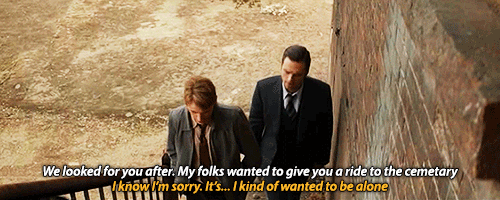
So either Bucky was working like a damn dog supporting his family, in which case the fuck are you doing in an art class, kiddo? Or he was actually a student at a college or university.
.....he could also have, during the years the US was gearing up in case they were forced into the conflict, held a job that was considered vital to the coming war effort. This sort of deferment was limited to jobs in war production, and jobs that involved national 'health, safety, or interest'. Literally the only job I can think of without actually like . . . researching it, that Bucky could have been in where he would have been skipped the first few times but taken in '42, is if he had been a police officer. That would fit very well with his ability with a gun, plus explain why he made sergeant so fucking fast, with prior training other inductees would not have had.
Considering what a golden child Bucky was in Brooklyn, all three of those scenarios would be a perfectly valid reason for Bucky to have avoided the first several waves of conscription. Just thought that was interesting.
Anyway! Steve wants to enlist right away, so Bucky (a three-time YMCA welterweight boxing champion, suck it) trains him for two whole weeks because Bucky is apparently of the opinion that Steve is an idiot who won't get in anyway so why fucking bother going hard.

*at the time, under the regulations of the New York State Athletic Commission, welterweight was a weight class of 147 to >160 pounds. Meaning post-war Bucky gained about 40 pounds of pure muscle after getting the serum....dude.
December 24, 1941 - Bucky is right and Steve's first attempt to enlist fails so hard. Go to Midnight Mass, Steven.
March, 1942 - Red Skull fucks shit up in Tønsberg, Norway and finds the Tesseract.
September 21, 1942 - Bucky receives his draft card, and takes it to an intake facility and enlists in the US Army. The following dates are literally nowhere in canon, but I have research to back up what is essentially pure speculation on my part. His serial number is 32557038. There is a real world counterpart who actually had this particular serial number, and he was enlisted on this date. So, in order for Bucky to have gotten to the number before this guy, Bucky probably woke up early Monday morning to get shit done.
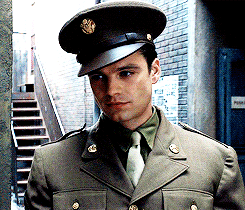
Desperate Historian's Note: I always assumed that since he was a Sergeant when he first shipped out, Bucky had been in service for at least a year and a half, which is still pushing it within the constraints of the timeline. Most NCO's at the start of US involvement in the War, Corporals and Sergeants, already had years of Army service under their belts. But no. 9 months. So. Bucky basically kicked ass and took names to become a Sergeant in 9 months of non-combat training (which took place at Camp McCoy, Wisconsin btw). That, or every NCO in his regiment came down with a sudden case of the Deads and he got promoted.....Bucky would have needed a special recommendation from the company commander - TWICE in 9 months - to reach that rank. Jesus. It is canon fact that Bucky was indeed an absolutely phenomenal soldier (and leader) . . .

He would have been sent to basic training and been gone for ten weeks, meaning it would have been over by the 1st of December, 1942, or thereabouts.
December 1, 1942 - Give or take a week or two, maybe, depending on how quickly he was whisked away after enlistment, Bucky would have been given a week's furlough after training at Camp McCoy ended.
December 8, 1942 - Since he is a designated marksman (not a sniper, the US Army didn't have those in WWII. A designated marksman was just a guy in a regiment who was an excellent shot and stuck with their regiment at all times and was used situationally, never went off alone to shoot people in the head and stuff), he absolutely would not have been sent to any sort of sniper training because, again, the US did not have those in WWII. He wouldn't have stayed in NYC, though.
He would have been on an Army base somewhere, with the occasional week-long furlough to return home. There were 114 mobilization camps by 1942, and only three of those in New York state; Madison Barracks, Camp Upton, and Pine Camp, with three more in New Jersey; Fort Dix, Fort Monmouth, and Camp Shanks. 17 were in California, 14 in Texas. Anyway. So, before Bucky leaves for war, he and Steve wouldn't have seen a whole lot of each other for the year before that, either.
June 7, 1943 - Bucky probably arrives in NYC on a final week's furlough before being sent to War. With the way Steve looks at him when he sees the uniform later on, and Bucky's cocky little head tilt, it's probably safe to say Bucky received his sergeant's chevrons not long before this furlough. (Honestly . . . I have never understood this part. Bucky damn well knew he was 107th from the moment he reported, and Steve should have as well. Also, ‘getting his orders’ had nothing to do with his uniform, soldiers were required to wear that shit everywhere they went. Unless Steve knew he’d gotten his orders simply because he was there and shouldn’t have been....whatever, movie exposition, blah blah)
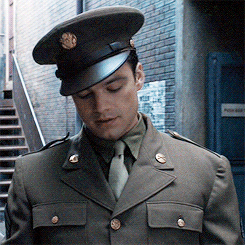
June 14, 1943 - Steve's fifth attempt to enlist fails spectacularly because he had to claim to be from New Jersey. He then goes to get the shit kicked out of him in an alley behind a movie theater, that's what you get for saying you're from Jersey, Steven. He and Bucky attend the Stark Expo that evening, where Steve ghosts like an asshole - even though for all he knows this is literally the last time he will ever see Bucky alive!! - and is chosen by Dr. Erskine as a candidate for Project: Rebirth.
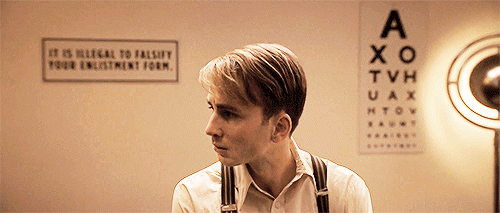
June 15, 1943 - Bucky and the 107th ship out for 'England'. Now, the troop transport Queen Mary left NYC on June 1, 1943, heading for Gourock, Scotland and carrying the 1077th Signal Company Service Group. It took 5 days; they arrived on June 6, 1943. On July 16, 1943, the Edmund B. Alexander carried 5,000 replacement troops to Liverpool, England. That journey took ten days; they made land on July 26, 1943. Maybe. The records are full of literal question marks, so I dunno. That's the closest thing I can find to Bucky's stated journey. Most of the troops leaving from NYC at this period were actually heading for Africa, landing in Casablanca, Morocco.
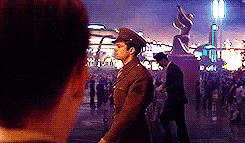
I know Bucky says he's shipping out for England in the morning, but it makes so much more sense that the 107th would have been sent to Africa and then swept up into Italy in the next four months of fighting, where Steve finds them later. It would be easy to deal with this by either saying Bucky's an idiot, or (my recommendation) that Bucky knew exactly where he was heading and he just wasn't telling Steve that he was being sent into the heart of the brutal African and Italian campaigns rather than a nice balmy Liverpool in the summer. The journey from NYC to Casablanca, Morocco would have been anywhere from 11-15 days.
June 20-25, 1943 - Bucky would have hit Liverpool, England right around this time, if that's the way he was sent.
June 25-30, 1943 - Bucky would have docked in Casablanca, Morocco, if this is the way it went instead. So I guess you could safely say he made landfall in the European Theater on June 25, 1943? Haha right in time for Mussolini to get his ass arrested and the Italian Fascist government to fall.
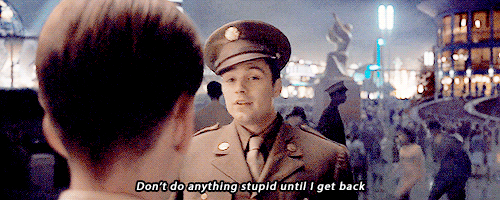
June 22, 1943 - Steve is injected with the super-soldier serum, right Steven? (Meaning he only had a week of basic training, at most, and everything else he knows about being a soldier he taught himself with all those books he brought to Camp Lehigh with him.)
September, 1943 - Ugh, okay, history nerds cover your ears, because there is just no way to make the real invasion of Italy match up with the MCU invasion of Italy. Unless the 107th just said fuck those guys and marched right into German territory past the . . . bombs and stuff. On September 9, there were Allied landings at Salerno and Taranto, Italy, and they didn’t enter Naples until October 1. I mean, is it really all that shocking that they got their asses kicked in Azzano? NO. But having a fucking USO show that deep into Italy means the MCU said fuck it, so you too can say fuck it when it comes to the real WW2 timeline in Italy, idfc. This is apparently what the MCU lines looked like at this point in time, and let me just tell you, see that bulge there, right under the Hydra flag? Those fuckers would have been surrounded and cut off so fast, so fast, just like in Bastogne. Assholes....anyway.
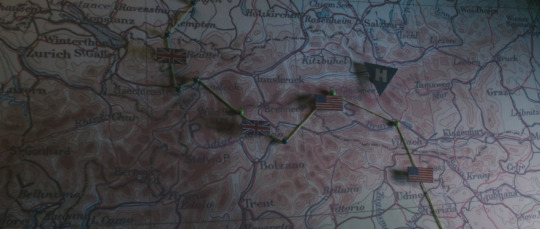
October, 1943 - The Battle of Azzano results in Hydra declaring war on anything that moves, including Nazis, and takes prisoners from various different regiments that historically were either still in training or in the Pacific Theater at this point, but that's fine. Prisoners are taken over 120 km away to a Hydra weapons factory in Kreischberg, Austria, where their Hydra captors separate the men into cages according to their nationality and other factors. The purpose of this is for the bickering hodgepodge of Allied soldiers to keep each other busy with in-fighting so the Hydra guards can forget to train and get beat up by Captain America in a month or so.
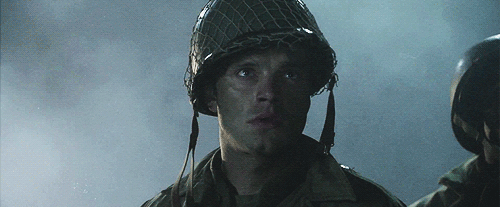
Dum Dum Dugan almost immediately makes a joke while Cage Team Howling Commando is introducing themselves, and a brawl breaks out. As you do.
In Bucky's cage are the following:
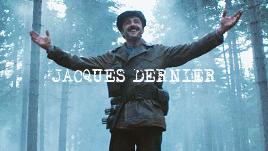
Jacques "Frenchie" Dernier, French Resistance, born January 2, 1911 (32). The fuck was your French ass doing in northwestern Italy, son? To my knowledge the French Resistance kind of worked mainly . . . in France. The Italian Resistance was very active in this period, so they could have been collaborating, but that's not what the Resistance did, mostly. So the only logical conclusion we can come to with Frenchie is that he was captured somewhere in France by Hydra and transported to the factory as labor. He lived in Marseilles before the War, and likely would have stayed close to it.

Major James Montgomery "Monty" Falsworth, born January 2, 1914 (29), of the British 3rd Independent Parachute Brigade, which historically first saw action in June of 1944, ha. Anyway, Monty was from Birmingham, England and was known in the comics as Union Jack, and the pin on his beret is a nod to that. Teeeechnically? Monty outranks Steve, but since they're not even part of the same Army, that's kind of a moot point. He winds up with the rank of Brigadier, which wtf, that means he outranked Colonel Phillips when the war ended . . . four for you, Monty.
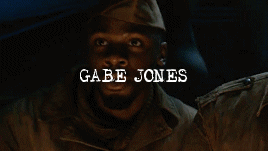
Private Gabe Jones, born August 14, 1918 (25), was 92nd Infantry Division, a segregated unit that historically first saw action in September of 1944, haha. Gabe was from Macon, Georgia and was fluent in French and German thanks to pre-war studies at Howard University. Just as proficient in hand-to-hand as the others, he was often part of the team’s frontal assaults, as well as handling the radios . . . and he boned Peggy Carter in the comics.
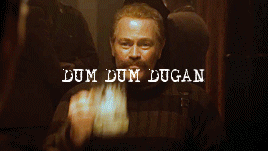
Corporal Timothy 'Dum Dum' Dugan, born April 11, 1912 (31), was a member of the 69th Infantry Regiment, which is also known as the 165th or Fighting Irish, recruited solely from NYC, who were making landfall in the Pacific right about now. Frustrated historian's note: Had he been a real boy, Bucky Barnes would have been enlisted into the 69th Infantry as well, just like Dugan. Canon-wise it makes sense that Bucky and Dugan were from the same unit, even though canon thinks they weren't because canon made up the WWII-era 107th? Anyway, the fact that both Dugan and Bucky were in the same foxhole when the Hydra tank hits in the cut scene from First Avenger is all fucked up because you don't put your NCOs where they can be blown up together, okay. It's bad strategy. Add to that the fact that Dugan calls him Bucky like they've been buddies for a while, but the tie-in comic is still on 'Jimmy' and also states that Dugan and Barnes were in the same company after all, that cut scene is frustrating. Or I guess the comic is frustrating? Something's frustrating, anyway. I think the best way to deal with this is just to say that the 107th IS the Fighting Irish regiment because fuck it. Dugan will eventually take over leading the team when Steve goes splat, leading the Howling Commandos and being involved with SHIELD, and Nick Fury personally, well into the Cold War.
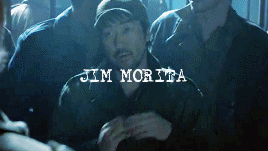
Private Jim Morita, born October 20, 1919 (24) - also, Happy Birthday here's a Hydra weapon NOW ASSEMBLE IT - wasn't in the same cage as the others, but he served in the US Army's Nisei Squadron as a Ranger, aka the 442nd Regimental Combat Team. Their real fight in the European Theater began in June of 1944, so who the fuck knows how his ass wound up in Austria. And since the whole unit was made up of men of Japanese descent, it's safe to assume there's a 50/50 chance Morita was given the choice back in Fresno between enlisting and an internment camp. A lot of fics write Morita as the team medic, but I'm not entirely sure why. In WWII, medics held a rank of Private, Private First Class, or Technical Sergeant. So, the medic would either have needed to be Morita or Gabe Jones in keeping with this. But there is literally no canon mention of him being any better at triage than any of the others, and he is definitely not a medic by trade. None of them are. The more likely scenario here, because none of them wear the insignia of a combat medic, is that all of the team were equally trained and capable at the most basic of field triage, but the team itself probably flew without a safety net and used the medics from whatever regiment they were shadowing at the time.

Sergeant James Buchanan "Bucky" Barnes (26) - who you will notice is literally the fourth James in a team of 7 men - contracted what can only be assumed to be walking pneumonia on the battlefield of Azzano, and as his condition gets progressively worse in captivity, hastened by the hard labor of the weapons facility, he eventually becomes so weak that he drops several components in front of the officer in charge of the Facility, identified only as Colonel Lohmer. Lohmer beats Bucky like a rented mule, and when he's deposited back in his cage, the other four realize that if he's made to work again the next day, he'll die. They devise a plan to kill Lohmer, which would put one of the kinder Nazi assholes in charge who would allow Bucky to remain in the cages until he was able to recover. Their plan works, crushing Lohmer under a ton of machinery and symbolism and signifying the first time the soon-to-be Howling Commandos had worked together successfully. The soldiers return everyone to their cages after the accident to keep order, and Dugan tells Bucky that he's safe from Lohmer now, with the only punishment being a reduction of the POWs food rations for a week since there was no one specific to punish. Bucky is an ungrateful dick and not only asks Dugan to stop calling him "Jimmy", but graces him with the nickname Dum Dum in the process. Bucky is saved from dying on the manufacturing floor only to be singled out by Arnim Zola and taken to the 'examination rooms'. And we all know what happens there.
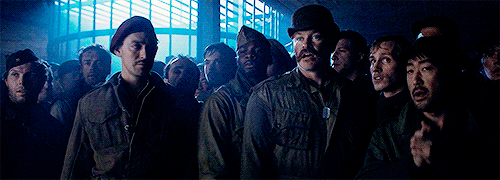
August to Early November, 1943 - Steve Rogers sings and dances his way through over 200 shows and makes several badly conceived films while his best friend is slogging his way through Italy.
November 3, 1943 - Steve disappears behind enemy lines to go find his Bucky.

November 8, 1943 - The Man With A Plan dramatically re-enters the Allied base camp where Colonel Phillips is fixin' to tear Peggy Carter a new one for losing Captain America over enemy territory. If the Battle of Azzano happened on a goddamn Earth map at the real Azzano in the Province of Udine, and assuming the Allied camp was somewhat close to that area, the march from the factory back to the Allied base camp would have been well over 120 kilometers as the crow flies. Those prisoners were metal af.

I'm getting that date from the assumption that walking over 120 km back to (supposedly because in reality they'd have needed to walk to goddamn Naples) Allied territory with 400 sick and wounded men would take a few fucking days. An American unit in Sicily in WWII (30th Infantry Division) marched 54 miles in 33 hours across country. But it's safe to assume that the company Steve rescues from Kreischberg would not be moving at top speed, but rather a steady pace that would keep them moving, but not fucking kill them.
The closest thing I can get to this incident is in July of 1944, when the German armies began a forced march of POWs across Germany to delay their liberation by the approaching Red Armies. Groups of 250 to 300 men marched over bombed out roads in a meandering route because they were forced to skirt around various battles, kind of like what our POWs would have to do in enemy territory. The groups would march between 20 to 40 kilometers a day, with very little food, clothing, shelter or medical care to speak of. Using 30 km/day as our benchmark, that's at least 4 days that it would have taken to get back to the Allied encampment. If the Hydra factory went boom on the night of November 3rd, and Steve flounced into camp in daylight, November 8th is a very safe bet.
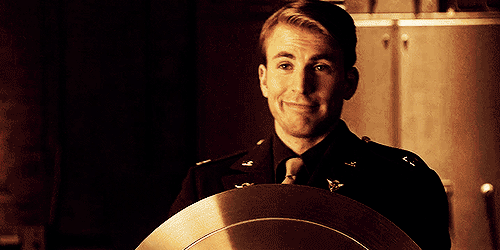
November 15, 1943 - Steve pinpoints the Hydra facilities on the map in the SSR bunker in London (which was located in the Cabinet War Rooms in Whitehall) and is given permission to form his own elite special ops unit. Sidenote, the Howling Commandos were never called the Howling Commandos until after the War ended, they were merely called the 107th Tactical Team. Another nickname bandied about in 'non-canon because it contradicts the movie ahahahahahah' was The Invaders, which is probably what other soldiers would have known them as when encountering them. Neither Steve nor Bucky would know what the fuck a Howling Commando even is until they read up on history, and even then neither of them would likely ever think of himself as a Howling Commando.
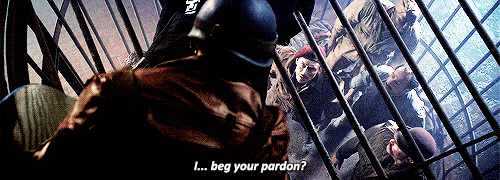
Now, in trying to find this date, my inner frustrated historian has begun to weep, because I just cannot find a base in Italy that makes sense for any of these damn movements to have been based out of. The Allies hadn't even gotten through the Gustav Line at this point, which ran across the boot and through the town of Cassino, south of Rome. For them to be in Northern Italy close to the Austrian border, dude. WTF were they doing there? And how did they get in and out?? I mean was anyone really surprised when their straying asses got pounded by enemy forces deep in enemy territory??

I have no idea how to judge how long it would have taken for the future Commandos to get to London and drink in a pub because there is literally no rational logic to pinpoint their starting location, and therefore no way to guess what modes of transport were even available to them so close to enemy territory. The easiest way to find this date would have been to find out what date Captain America was awarded his Medal of Honor, but . . . even I'm not that good, apparently, 'cause I can't dig up shit. The Medal of Honor ceremony that happens at the same time as this scene would have been at least a week and probably more from the action on the night of November 3rd simply because it took that long for the paperwork to travel back to Washington. It was usually months before soldiers received their Purple Hearts, for instance. But let's assume this was fast-tracked because it's Captain goddamn America. Let's also assume they didn't have Howard Stark fly them back to London in his plane and tell the other 400 POWs to go make like a leaf and fuck a tree or something.

So the trip back to London probably took at least 7-10 days. We also need enough time to have passed that they expected Steve to get from the front lines all the way back to DC for the ceremony. My first instinct is to say up to a month could have passed when this scene comes around, but a month just seems way too long when looking at the context of the scenes, from the celebratory pub crawl of the POWs to the fact that Steve is being debriefed here, which would have been literally the first concern of an agency whose job is gathering intelligence.
TL:DR version, this could be anywhere from a week to a month later, idfk.
It's safe to assume this is also the night of the pub when Bucky reveals how heterosexual he is not by asking if Steve is going to keep his stage suit for no apparent good reason.

Mostly I'm putting this date here because it is the day the Allied Expeditionary Force for the invasion of Europe is officially formed. Having the SSR gearing up for - or as a result of - that meeting seems to make a lot of sense.
November 15, 1943 to March 4, 1945 - Steve and the Invaders, often along with other military forces, plow through HYDRA factories like an enraged ex with a John Deere tractor and a bottle of Jim Beam, and also join the larger battle against the Axis Powers on the Western Front. Essentially this period is Band of Broooos: Howling Commandos Edition. This period is where you can really have your fic fun, because canon doesn't tell us fuck all about it.

Well . . . that’s not necessarily true, though. Through the (paltry imo) Howling Commando montage of the movie, we see at least 10 distinct missions, and in clips from TWS there are hints of a few more; as many as 15 total. There are 6 Hydra facilities on the board, labeled 1-6. #4 was never taken during Steve’s time. But we can assume at least 5 of their missions were blowing the rest up. One was ‘in Poland, near the Baltic’, the other was ‘30-40 miles west of the Maginot Line’, thanks Steve. That doesn’t give us shit, son. But I will try.
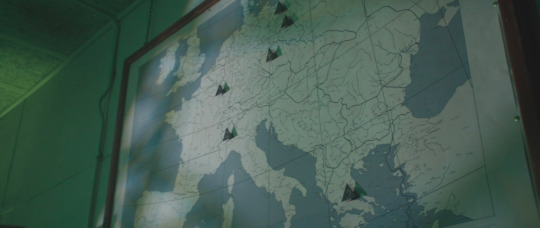
1. A Hydra facility raid, #2. This is the one 30-40 miles west of the Maginot Line, labeled #2 on the map. West, in fact, of Liechtenstein, and southeast of Innsbruck, in a town that begins with RES. I think this is Resia, Italy, and the Reschen Pass (Resia Pass in WW2), which would make sense, tactically. I’d like to point out that they show Bucky entering with the team, show the team running out, show Steve riding out on his motorcycle, and then the place blows up. No Bucky. Take better care of your marksman, boys . . .

2. An approach with additional military forces through a forest, in the snow. Look at those BAMF motherfuckers. I got no clue what this mission could be, though. This has the feeling of a patrol, rather than a directed attack on anything. Bucky doesn’t even have his rifle.
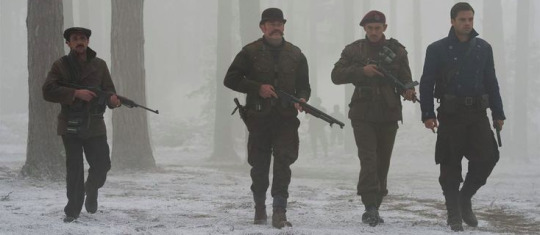
3. A direct attack through a forest of exploding trees . . . no snow. This is probably a frontal attack intended to push at the enemy lines. With mortars like that coming at them as they advance, there’s no way whoever they were facing wasn’t dug in on a forward line.
4. This is most likely a harassment mission. They’re shown disturbing the lines of supplies to somewhere, and taking care to be covert, which is . . . not usually how Steve rolls, lbr.

5. Another Hydra base raid, Base #5. This is shown through only film, with Steve planning an approach to somewhere and a whole shitload of troops mobilizing with them. From where they are, he’s pointing south. God help me. Looking at the map he’s pointing to, the best guess I have based on the coastline is that it shows the northern bits of Belgium, and he’s pointing toward Hydra base #5, which is somewhere in the northeast corner of France, right below the border of Luxembourg.
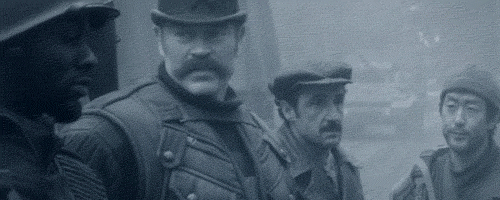
6. Seek and destroy mission. This was another battle, not a base. Despite the fact that they’re in rubble, but then . . . most of Europe was rubble at this point, lbr. Peggy pulls a ‘Hydra battle lines’ flag from the map after this mission, so this was about pushing the forward line back. And we know this was the Hydra line, not the Nazi line. The scene we see was likely after the battle itself was over, when the search for the wounded and intel begins; that’s when enemy snipers made their last stand, like the one seen stalking Steve’s oblivious star-spangled ass. Bucky almost kills Steve for saluting at him and giving away his carefully chosen position.
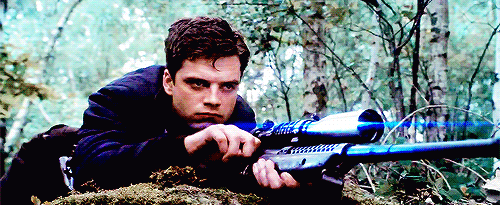
7. A pitched battle in a town, somewhere. Steve is seen kicking ass and stuff.
8. Cool guys don’t look at explosions . . . The only reason I am separating these three clips is because the middle one is obviously in a forest, where the other two are in towns. We’ll call them three separate skirmishes. I would imagine all three of these are about pushing back that forward line.
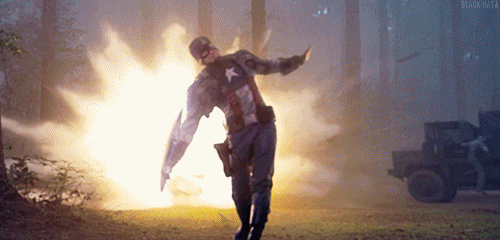
9. The mega huge tank in the middle of town. I can see the team being sent out just to take care of this thing. Historian sidenote; the Nazis did indeed cook up some monster tanks. Hitler had a size kink. The Tiger II, or as the American GIs called it, the King Tiger, was . . . I mean, you were fucked if one of these rolled up into your path. They were damn near indestructible and they carried a big fucking stick. The problem with a heavy tank is that a Europe that has been bombed back to Creation for several years is a muddy Europe . . . if that Hydra tank wasn’t stuck in 5 feet of mud it was made of aluminum or something.
10. A last Hydra base raid, Base #?. This is shown only through the resulting smoking husk of a destroyed base and Red Skull being a diva. I don’t know which one this was, other than knowing it had to be #1, or #6. I hate to tell Steve, but I’m not sure any of the flags on this map are in Poland near the Baltic Sea, my dude. It would have to be #6 that he was talking about, though. #1 is just northeast of Lübben, Germany, in what appears to now be Briesensee nature preserve.
The only other hints we get at their missions are the clips of footage from TWS.
11. Hydra Facility #3. #3 is in the south of fucking Greece, near the northwestern tip of the body of water called Maliakos Kopos. There’s a marina in that area, Agia Marina, that would make a very convenient Hydra facility if I do say so myself. Now, this looks like a water landing! And it’s not an ocean landing, so that marina at facility #3 might be the ticket.
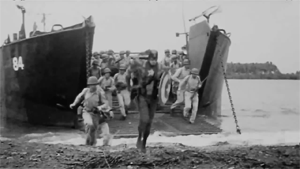
12. I’m going to call this a Hydra Facility Raid. Look at him go. There he go. Again, this is either #1, or #6. idfk anymore.
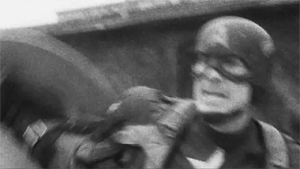
13. Prisoners. Cap is seen escorting surrendered German soldiers, It’s notable that they’re not Hydra, so that would be one of the ‘regular’ missions they ran with other troops. It could be part of any of the above missions, though.
14. Clearing out a town left by retreat. Those soldiers are not particularly the kind of alert that possible enemy combatants in the weeds will make you, so that town has probably been cleared.
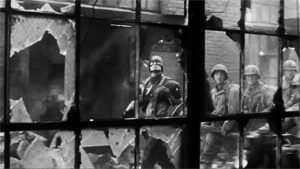
15. Troop Transport/Advancement. This is notable because it’s a bridge, and not a little stone bridge, either, it’s a big one. In fact, this is the Ludendorff Bridge over the Rhine. (You can learn more about the capture of this bridge by looking up the Battle of Remagen.) Bridges were kind of a big deal at this stage when the German army was pulling out all the stops trying to prevent the Allied advance. Bridges large enough to convey heavy artillery got blown up but quick. This bridge in particular was front page news when it was captured by the Allies. Unfortunately, we can’t place Steve and his team at the Battle of Remagen, or at the Ludendorff Bridge, because this happened just days after Steve nosedived into the Arctic. So. We’ll call it an MCU bridge! This was either coming back from the front and they were deeper in Allied territory, or more likely after a battle, but on the way to the new front lines, as established by the winning of the goddamn bridge. Doubt this was a Hydra mission, either.
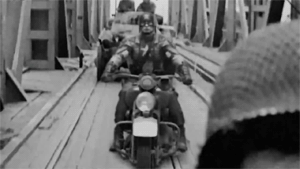
All in all, Bucky and Steve have 16 months of battle side-by-side. Bucky would have had 20 months total of combat service in the War.

I'm going to list some real events from the War during this time that the team might have been involved with or nearby for that could fill in some of those non-Hydra missions above, and some things they would definitely have at least talked about. You can skip these if you like, just scroll down to the next bolded bit. I am copying and pasting these because I can:
December 2, 1943: The Germans conduct a highly successful Air Raid on Bari, Italy. One of the German bombs hits an Allied cargo ship carrying mustard gas, releasing the chemical which killed 83 Allied soldiers. Over 1000 other soldiers died in the raid.
January 17, 1944: The first Battle of Monte Cassino begins when the British X Corps attacks along the Garigliano river at the western end of the German Gustav Line.
January 20, 1944: The U.S. Army 36th Infantry Division, in Italy, attempts to cross the Gari River but suffers heavy losses.
January 22, 1944: Allies begin Operation Shingle, the landing at Anzio, Italy. The Allies hope to break the stalemate in south Italy, but they are unable to break out of the beachhead and the line holds until late May.
February 15, 1944: The second Battle of Monte Cassino begins with the destruction of the historic Benedictine monastery on Monte Cassino by Allied bombing. The Allies believed the grounds were used as an observation post by the Germans
February 16, 1944: Germans launch a major counter-attack at Anzio, threatening the American beachhead.
March 15, 1944: The third Battle of Monte Cassino begins. The small town of Cassino is destroyed by Allied bombers.
April 27, 1944: The Slapton Sands tragedy: American soldiers are killed in a training exercise in preparation for D-Day at Slapton in Devon.
May 8, 1944: D-Day for Operation Overlord set for June 5.
May 11, 1944: The fourth battle of Monte Cassino begins led by general Anders of the 2nd Polish Corps.
May 18, 1944: The Battle of Monte Cassino ends in Allied victory. Polish troops of the 2nd Polish Corps led by general Władysław Anders capture Monte Cassino. German troops in west Italy have withdrawn to the Hitler Line.
June 4, 1944: Allies enter Rome, one day after the Germans declared it an open city. German troops fall back to the Trasimene Line. Meanwhile, Operation Overlord is postponed 24 hours due to high seas.
June 5, 1944: Operation Overlord commences when more than 1,000 British bombers drop 5,000 tons of bombs on German gun batteries on the Normandy coast in preparation for D-Day. And the first Allied troops land in Normandy; paratroopers are scattered from Caen southward.
June 6, 1944: D-Day begins with the landing of 155,000 Allied troops on the beaches of Normandy in France. The Allied soldiers quickly break through the Atlantic Wall and push inland in the largest amphibious military operation in history.
June 10, 1944: At Oradour-sur-Glane (a town near Limoges), France, 642 men, women, and children are killed in a German response to local Resistance activities.
June 13, 1944: Germany launches a V1 Flying Bomb attack on England, in retaliation for the invasion. The V-1 attacks will continue through June.
July 3, 1944: The Allies find themselves in the "battle of the hedgerows", as they are stymied by the agricultural hedges in Western France which intelligence had not properly evaluated.
July 24, 1944: Operation Cobra is now in full swing: the breakout at St. Lo in Normandy with American troops taking Coutances.
August 15, 1944: Operation Dragoon begins, marked by amphibious Allied landings in southern France. Elsewhere, the Allies reach the "Gothic Line", the last German strategic position in North Italy.
August 19, 1944: The French Resistance begins an uprising in Paris, partly inspired by the Allied approach to the Seine River.
August 25, 1944: Paris is liberated. The German military disobeys Hitler's orders to burn the city.
September 2, 1944: Allied troops enter Belgium.
September 6, 1944: The "blackout" is diminished to a "dim-out" as threat of invasion and further bombing seems an unlikely possibility.
September 9, 1944: The first V-2 rocket lands on London.
September 17, 1944: Operation Market Garden, the attempted liberation of Arnhem and turning of the German flank begins.
October 18, 1944: Hitler orders a call-up of all men from 16 to 60 for Home Guard duties.
November 1, 1944: "Operation Infatuate", an Allied attempt to free the approaches to Antwerp begins; amphibious landings take place on Walcheren Island. It would become a major supply port for the Allies by the end of the month.
November 20, 1944: Hitler leaves his wartime headquarters at Rastenberg, East Prussia, never to return; he goes to Berlin, where he will soon establish himself at the bunker.
December 16, 1944: The Battle of the Bulge begins as German forces attempt a breakthrough in the Ardennes region. The main object of Hitler's plan is the retaking of Antwerp.
January, 1945 - The only mission the MCU gives real details about comes from the Smithsonian Exhibit's interview with Peggy Carter (which you can watch in its entirety btw). The 'difficult winter, 1945' has to be January, and they were outside Stalingrad, Russia. During - or possibly in the aftermath of - a blizzard, Steve (and presumably the Commandos but fuck those guys amirite Agent Carter?) fight their way through a Hydra blockade that had been there 'for months', and saved half a battalion, over 1,000 men, who'd been penned down behind German lines. That's literally all we've got for mission details, and none of that makes any sense. Like any. At all. Why the fuck were they near Stalingrad?? How did they get to the Eastern Front, STEVEN???

February 1945 - Bucky falls from a goddamn train in the Alps. There is no resource to tell us how much time passes between Bucky's fall and Steve's supposed death in the Valkyrie. So let me get my history on for a second. On February 17, 1945, the British Special Air Service executed Operation Cold Comfort, a parachute drop raid near Verona, Italy with the objective of blocking the main rail lines through the Brenner Pass by landslide. The Brenner Pass is a mountain pass through the Alps which forms the border between Italy and Austria. Sounds familiar, right? (It's also featured on one of the Captain America covers, Captain America No. 33, 1943).
The operation would ultimately be a failure, but since Schmidt wouldn't have known that, hearing rumors of this operation, or even word that it had been attempted and fearing a second try, this could have been the inciting incident behind why he had Zola hauling his evil ass along that railway at a speed described as 'moving like the devil'. So we can safely put Bucky's fall between February 15 and February 25th. You could also stretch and say it was February 14th, if you are the reborn incarnation of Satan.
Now, by the end of February, the Red Army was sweeping through the northern regions of Poland toward the German border, moving north and west. It's a Russian soldier who finds Bucky in the Alps, so either that patrol was way the hell out of their lane, or . . . Bucky laid there for a while, folks. Seriously, the Red Army didn't even sniff the border of Austria until March 31, 1945 with the Upper Silesian Offensive. Which leads one to postulate that, a. the Russians who found Bucky were lost as fuuuuuck, b. the Russians who found Bucky were a rogue group who defected to Hydra after Hydra declared itself a separate entity from the Axis forces (doubt it), or c. neither Steve nor any of the rest of the team ever actually looked for Bucky's body, even after Steve went down in the Valkyrie, and he laid there for weeks. I honestly choose to believe one of the former, since the latter is just . . . I can't.
[No, you know what? Fuckin......frustrated historian meta addition.]

It's always bothered me that they might never have looked for Bucky's body, y'know?
I always assumed the arm got ripped off when he hit the side of the ravine. Like maybe he grabbed for or hit a ledge and the speed/height of his fall was just too great and it got ripped off. Because it's not crushed like it would be if he'd landed on it, it's a traumatic amputation. It almost had to have happened during the fall. Which could mean he'd have landed close to the edge, or maybe like hit higher up and tumbled until he was at the bottom instead of freefalling the whole way?
In his flashback, you can see he's still bleeding as the soldiers are carrying him. Bleeding a lot. If he'd been in the water or motionless in the snow for any amount of time, the bleeding would have at least become sluggish. He'd be hypothermic; his body would route blood away from his extremities to protect his vital organs, plus the blood vessels in the wound would be constricting due to the cold. But, if he'd been moving under his own power trying to get to help, it would explain why he's still bleeding; his movement kept the blood circulating where it would otherwise have clotted up.
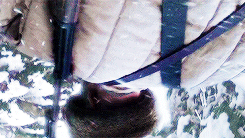
In this gif, it looks almost like the blood trail starts just a few meters away. If we take a leap and assume that when they started moving him it jogged him awake, then this scene shows where the Russians found him. Those are trees, aren't they? Meaning he moved under his own power after he landed. Meaning he got the fuck up after falling off that train, and walked through that ravine toward help. What a fucking badass, jfc.
Two things I think we can say with certainty; one, the Russians were definitely searching for someone. He's on a stretcher, which wasn't something a normal patrol would've been carrying, especially over rough terrain. They had it with them for a reason. And two, the Russians weren't there because of Zola. Between Bucky falling and Gabe taking the control room, he had very little time to get off a communication with sitrep and location. And even if he was able to, it would have been to Hydra troops, who would have shown up wearing Hydra gear. And Russians are almost certainly not part of Hydra at that stage in the War.
Those Russian soldiers were probably an Allied search party that was sent out to find Bucky. That would tick off a lot of problem boxes, wouldn't it? It would mean someone - the SSR, the Army - did order a rescue/recovery for a damned war hero like a fallen Howling Commando, and Allied Russian troops were closest or something. It would explain why Russian soldiers were in such a remote area, with a stretcher, when they had zero other reason to be there! It would explain why Bucky is listed as KIA instead of MIA even though they obviously never found his body. It would also explain why Bucky didn't struggle as they were carrying him off; he thought they were on his side, rescuing him.
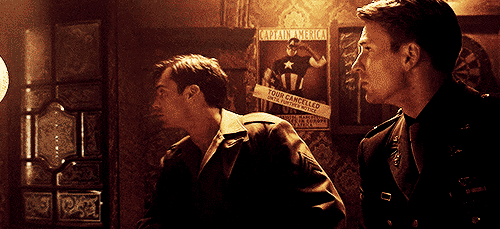
My theory after writing all this up? He lost the arm in an impact with the side of the ravine, but contacting the ravine walls also slowed his landing and put him on dry ground. He then got up like a BAMF and moved, either until he found shelter under some trees, or he simply collapsed from shock or trauma or exposure or all of the above. An Allied rescue/recovery party found him, but they were Russian, and they reported him KIA and kept him because they knew he must be enhanced to have survived that sort of fall, cold, and blood loss, and they wanted their own Captain Comrade.
March 4, 1945 - The SSR and other forces raid the secret Hydra bunker and Steve Rogers boards the Valkyrie on his way to getting fridged, literally haha, so Peggy Carter can become a hero . . . good job Captain Cannonball.
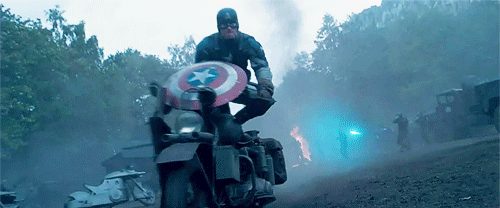
March 15-24, 1945 - The Commandos assist in Operation Undertone, which was part of the Allied invasion of Germany by the U.S. Seventh and French 1st Armies of the U.S. Sixth Army Group. It was a very real operation, so info is easy to find about it if your heart is still in your chest after watching both our boys plummet to their supposed deaths.
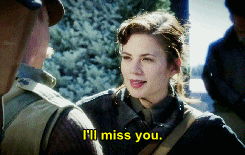
Some time in April probably?? 1945 - Dugan and Morita head to the last known HYDRA facility, Facility #4 bitches!, known simply as the Fortress, located some the fuck where in Austria, with Peggy Carter. They capture HYDRA General Werner Reinhardt and take possession of the first known classified 084, the Obelisk. We don't see the Obelisk again until Agents of SHIELD.
May 8th, 1945 - VE-Day. The remaining five members of the team gather in a pub to toast 'the Captain', suggesting that they did indeed just leave 'the Sergeant's' body rotting in the Alps somewhere, fuck that guy. (It is notable that one of the tie-in books for the movie states explicitly that they toast to both 'the Captain' and 'the Sergeant', so it's probable that they gave each man his own, individual farewell. We just didn't see it.)

(If you want more timeline! Trying to track the Winter Soldier through both canon and history.)
#steve rogers#bucky barnes#Howling Commandos#history nerd rants#research#fic reference#history sorta#timeline#meta maybe?#captain america#ca:tfa#MCU detail references
5K notes
·
View notes
Text
WHAT THE ALTAIR BASIC OF GREAT
But the more general recipe is: do things with style. That's supposed to be the series A stage. I finished a new book, and in another it's considered shocking. Whatever their ideas were, they were ideas reasonable people could believe. But even if the founder's friends were all wrong and the company is a good deal of effort into seeming smart. Standards are higher; people are more sympathetic to what you're doing; the kind of people you interact with is about right. You can sense it when you walk around one. At least, it did when people wrote about it in 1974, off 98% tax on investment income. Everything would seem exactly as he'd predicted, until he looked at their bank accounts.
A List of people who have it are not readily hireable. It's something the market already determines. She'd seen the level of vitriol in this debate, and she shrank from engaging. I read an interview with Joe Kraus, the co-founder of Excite. The problem was not the 14 pages, but the truth turns out to generate more jobs. If you mean worth in the sense of wonder you had about programming at age 14. We probably had 20 deals of various types fall through.
The way to do that instead of becoming a serious rival to Silicon Valley? 0: their core business sounds crushingly hip when described in Web 2. They think that there is now a lot of competition for a deal, the number that moves is the valuation and thus the amount invested. But it's harder, because now you're working against social customs instead of with them. I know of, on any subject. It's more a question of self-preservation. It could be anywhere—in Los Alamos, New Mexico, for example, that you're recovering consciousness after being hit on the head. We often like to think of World War II it was used extensively by Churchill and his supporters to silence their opponents. It is probably inevitable that parents should want to dress up their kids' minds in cute little baby outfits.
On the surface it feels like the kind of determination it takes to start a startup and fail your net worth will be zero rather than negative. In the Q & A period after a recent talk, someone asked what made startups fail. 7 billion. He really doesn't know. You might find contradictory taboos. Another reason not to take stock in return for the unique privilege of sharing his office with no other humans, he had to decide what Apple's next products should be. In a free market, prices are determined by what buyers want. Natural selection, for example, seems to have started to matter for men as well. I'm right, then it really pays to keep a company as small as it can be hard to tell exactly what message a city sends without living there. What they won't do is agree not to move the next time they need funding.
If what you write is popular, or entertaining, or funny, you're ipso facto suspect. Her immense data set and x-ray vision for character. This is one of the main things that separates the most successful startups seem to have been labels that got applied to statements to shoot them down before anyone had a chance to ask if they were a distinct group. I am now, but was among the poorest, or in Germany in the 1930s—or among the Mongols in 1200, for that matter? Pascal is too wimpy for systems programming. You can change anything about a house except where it is. Working for yourself doesn't have to mean starting a startup right out of college, but only because they're that much older. Yes and no. But even if the founder's friends were all wrong and the company is at least a million dollars if they'll relocate to your city, and Silicon Valley is not even that. The total amount of desirable startup stock available to investors will probably increase, because the less smart people writing the actual applications wouldn't be doing low-level.
I can see why political incorrectness would be a pretty cheap experiment, as civil expenditures go. You still need just as much of their energy and imagination, but they also make you big, because you need more of them to solve a lot of nasty little ones. Scientists go looking for trouble. As it widens out into a pyramid to match the startup pyramid, all the contents are adhering to the top, leaving a vacuum at the bottom. Our startup made software for making online stores. The best of these explorations are sometimes more pleasing than stuff made explicitly to please. The reason I describe it as an opportunity is that there will start to be an obelisk will become a pyramid. After that she told the PR firm to get her some interviews. There's something that needs to happen first. The usual way is to hire good programmers and let them make the choices. You can see that from how randomly some of the most successful startups from the rest. They just sit there quietly radiating optimism, like a battery that never runs out.
Maybe the Internet will change things further. The hackers who become famous tend to become famous by random accidents of PR. But it was not till we ourselves raised money that I understood why. The recording industry hated the idea and resisted it as long as they still have to show off with your body instead. Then you'd really be in good shape. Can you cultivate these qualities? That was the point of creating it. Historically the closest analogy to what he does are the great hackers I know seem to have become professional fundraisers who do a little research on the side of generosity. But as long as they still have to show off with your body instead.
#automatically generated text#Markov chains#Paul Graham#Python#Patrick Mooney#ones#Apple#startup#War#ideas#Silicon#Standards#Web#Los#fail#people#pages#money#Internet#age#minds#things#imagination#programmers#vision#way#incorrectness#supporters#selection#market
0 notes
Note
A couple of my friends recently went on vacation to Greece (Santorini, specifically) and discovered that Greeks were actually some of the hardest-working people they've ever met. In your experience, how true is this? Is the whole "lazy Greeks" thing completely unjustified? Based on a kernel of truth? Or actually true and the folks in Santorini are unusually hard working?
First, I’d like to point out that Santorini is interesting because it’s almost certainly the location of the city known as “Atlantis,” as this fascinating and very well done BBC documentary establishes. As the documentary describes, the destruction of Atlantis - by a massive volcanic event much like the devastating Krakatoa explosion - didn’t just destroy a single prosperous trade city, but brought on a devastating “nuclear winter” effect recorded by other contemporary sources, including Egyptian hieroglyphic records, and plenty of archaeological evidence of the actual eruption and following tsunamis. The eruption did terrible damage to the ancient Minoan civilization, quite likely leading to their downfall.
The island of Santorini is a volcanic island, created by a still-active killer of civilizations. They are still unearthing the remains of more outlying settlements on the island that were not utterly vaporized like the city that was built pretty much on top of the volcano’s central cone (in what is now the central bay, after the volcano collapsed into its own magma chamber and the sea rushed in,) so the echoes of the victims of this island are still all around it.
Now check out this picture of lovely traditional Greek-style houses built along the rim of the god-damned crater. GREEKS STILL LIVE ON THIS FUCKING BASTION OF HADES. Consider what that says about Greeks.
With that reflexive horror out of the way, about Greeks - the most important thing to understand about Greeks is that Greeks are fucking poor. They have always been pretty damn poor. Even in antiquity, if you weren’t Athens? You were fuckin poor. And you need only look at the terrain to tell why - they joke that Greece is the only country where farmers can literally fall out of their own fields, because so much agriculture has to be done on terraces cut into mountainsides. And though Greece’s mineral wealth isn’t terrible, it never really had the domestic industry needed to capitalize on it. Greece could’ve overcome this with time, but 300 years of domination and exploitation by the Ottoman Empire, followed by invasion and occupation in WWII (the German army stripped Greece of almost every machine tool and working factory it had), followed by a civil war with Communists, meant that the nation’s been kicked in the head so many times it never really had a chance to find its feet. My own grandfather sailed sail-powered clipper ships around the Greek islands as a boy in the 1930s (a lot cheaper to operate than a modern steel ship with a proper engine, you see,) and the island my father’s side of the family came from, Kalamos, didn’t get electrical service run to it until 2005. For most of history - and still, today - Greeks have had to be hardworking just to survive.
Researching the novel I’m writing set in 1930s Greece gave me some rude shocks - it was Greek-Americans who raised the money to send Greece’s athletes to the Olympics in 1932, and in the run-up to WWII, the Greek government actually raised funds from the people directly to repair and upgrade their decaying WWI-era airbases. One of the tales of the war itself, heard from a friend of my grandfather’s, concerned how the Greek soldiers in the mountains, fighting the invading Italians, fed themselves - they waited till the Italians put their spaghetti pots on the fire, then they’d charge in, fire a few rounds, throw a few grenades, and while the Italians were still tripping over themselves they’d steal the spaghetti pots right off the goddamned fire.
Yeah. Greece was - and is - fucking poor.
The BBC actually has an article about the Lazy Greeks stereotype, and it shows that Greeks work more than most of the EU - Greece’s real problem is that, just like the EU, it embraced socialism, and that’s not working out too goddamned well for them. Greeks are of the opinion that the EU is fucking them over, destroying their economy to make them a source of cheap labor. Maybe it’s bullshit, but you have to remember that this isn’t the first time Greece has been under international financial controls - their economy was so fucked that they were put under international economic control in 1897. This is how far back the debt crisis goes.
It’s not just “oh noes socialism” that fucked up Greece, however - it’s well known that Greece’s civil government is a fucking trainwreck and that tax evasion and tax fraud is rampant. My family still owns our small plot on Kalamos, and when we looked into selling it, or building on it, we found out quickly that you pretty much need to hire a lawyer full-time to navigate the un-ending clusterfuck of their civil government - to say nothing of the bribes you might have to pass around. This, unfortunately, is what you get from a nation who had a strong tradition of being Turk-killing hill bandits for 300 years, had to fight a series of wars just to survive against their Balkan neighbors immediately thereafter, was brutally sacked by Germany and then had to dive head-long into the international Communists Versus Anti-Communists battle along with everyone else. Despite defeating the Communists - narrowly - victory in the civil war never really resolved the tensions in the populace (any more than our own did,) and even worse, the alternative to Communists, in Greece, was pretty much always nationalists - they remained popular enough that Greece was taken over and ruled by a fucking military junta from 1967-74. The current Golden Dawn fascist party in Greece are big fans of these fucks, naturally. I call them nationalists because Metaxism was always fascism-lite at best; they were literal royalists (both in Metaxas’s time and in 1967, Greece had a King who had actual political and legal power,) so the emphasis on nationalism and political loyalty were simply to maintain control over a restive and divided populace, rather than underpinned by any really hardcore radical fascist shit. It was even rumored that Metaxas was moving towards restoration of democratic government in the late 30s before he was Overtaken By Events.
Unfortunately that’s left Metaxasim with just enough respectability that the Junta - and their current admirers - were able to gloss over the dictator part of “benevolent dictator” and all the police state, jackbooted-thug oppression that implies. So today Greece still has unironic anarcho-communist fuckheads running loose, and a bunch of unironic nationalists just itching to go full jackboots on their ass.
Now I’ll be the first to say I’m not intimately acquainted with modern Greek politics, but you can clearly see the modern cracks line up pretty well with the historical tensions. Any way you dice it, modern Greece just isn’t a very unified state or people. It’s not full Balkans mode mind you, but it’s not hard to see how graft and corruption are still rampant in their civil government; they never really had the long period of stability required to hammer out that kind of society.
And there’s a second problem, too - the long history of Greece being used by a pawn against outside powers. The Greek War of Independence was backed by Europe, first by wealthy individuals and groups, and then by direct national governments deploying their fleets and soldiers. It was primarily a way to fuck with the Ottoman Empire, which’d been Europe’s enemy since before corned powder. This would continue through the Balkan Wars and into WWI, where Greece’s northern half actually revolted to give the British a casus belli to open a new front against the Central Powers, and of course WWII, and after that, the Greek Civil War would become the first foray of the CIA in anti-Communist dickery. The CIA was also balls-deep in the 1967 Junta, in fact, for the same reason - hold off the Commies. And all of this, of course, included Money. There was always more money from the US or Europe or NATO or England or whoeverthefuck, and it always had strings attached. Greece is very strategically located - if Turkey (and the Bosporus Strait) ever left NATO, than the Greek islands in the Dardanelles could control access to the Black Sea. So there’s almost always been outside flows of money to exploit, which lessened the dire necessity of actually unfucking their own civil society, and thus economy.
Greeks work very hard - it’s just that their entire government is kind of fucked up.
8 notes
·
View notes
Text
Getting to know you meme
Okay. Okayokayokay. I said I was going to post more, actually engage more, so that requires, you know. Actually posting more. (Plus @momosandlemonsoda has graciously tagged me twice now, with no response from me, and that shall not stand!)
So. That meme thing going around.
Part I
name: Fannishly, I’m uschickens pretty much everywhere. Back in The Olden Times, I used Vix as my first name with uschickens, as in short for Vixen, as in a fox in the henhouse, which, like so many things with me, is so obscure as to only amuse myself.
star sign: Sagittarius, which seems a little ::skeptical headtilt:: at first, until you pair it with my Gemini rising and Virgo moon, and then it becomes a lot more we-know-but-hey-john-mulaney.gif
height: 5'5" (165.1cm)
time: 11:12pm
birthday: every handful of years, it coincides with Thanksgiving, so I get cake AND turkey.
nationality: american
fave bands/groups/solo artists: Like, currently listening to, or of all time, or or or??? This is a loaded question! Recently, Taemin’s Never Gonna Dance album hooked me hard. My other most-played playlists are called “last of the hardcore troubadours,” “frenzied banjos,” and “forest gods,” so I’m working the alt country/folk pop/whatever Florence and her Machine and Hozier have going on. Oh, and the Sleep No More soundtrack, so 1930s jazz, Hitchcockian strings, and edm all mashed together.
song stuck in your head: not even a song, just the one line from Taemin “we were just two kids/too young and dumb” over and over and over on repeat.
last movie you watched: I...have not watched a movie in a long, long time. Possibly a Knives Out rewatch? It Part Two? No, all my media consumption time lately has been devoted to...
last show you binged: All Things Tomb. I started watching reboot in, hmmm, late October? Early November? And with very few exceptions, various dmbj adaptions have been ALL I watched since then. It’s...kind of a problem. It goes in fits and starts, not a true binge since reboot, except for some blocking-out-the-outside-world plunges into Ultimate Note in early January. Reboot is the Tomb of My Heart, with Sha Hai a microscopically close second. Chen Minghao is my one! true! Pangzi, with surfer!Pangzi from tlt2 being a worthy predecessor. I am mostly here for post-Bronze Gate Wu Xies, and I vastly prefer the more realistic fighting style of reboot!Xiaoge than emo!XG, mathnerd!XG, or dancer!XG. But this was supposed to be about a binge, not my Standard Tomb Opinions Dissertation.
when you created your blog: 2010? There was a brief period when apparently I used tumblr for...interior design porn?? Rather than porn porn??? I quickly learned my lesson.
the last thing you googled: firstly, that would be the last thing I duckduckgoed, if we’re being strictly accurate, but I digress. It was [Richard Diebenkorn Guggenheim], part of a long-running conversation with my dad, who is a landscape painter currently going through an abstract expressionism phase. It’s getting wild up in here, folks.
other blogs: as I said, uschickens everywhere, by which I mean Twitter and dreamwidth and ao3.
why i chose my url: back in The Early Days of Livejournal, I lurked even more than I do now, so when I finally took the plunge, I couldn’t resist going with a name that really captured my inner Do Not Perceive Me, crossed with big band music and Louis Jordan. Ergo my tag line was “ain’t nobody here but... [us chickens]”.
how many people are you following: fuck if I know
how many followers do you have: fuck if I care
average hours of sleep: NOT. ENOUGH. But better than it used to be; see also my Twitter for some of the more bizarre paths my mind goes down when I’m in the middle of a juicy bit of insomnia.
lucky numbers: 3
instruments: a couple decades of piano and a solid eight months of French horn.
what i’m currently wearing: the dress I wore to work over pajama bottoms. I’m getting ready for bed, I swear. Halfway there!
dream job: ::hollow laughter:: I feel I would be excellent at being independently wealthy, at which point all my time would be devoted to travel, food, and writing about/photographing that travel and food, plus whatever experimental theater/circus/dance performances I happened to run across. But I shudder to think of actually relying on that sort of writing/photography to earn my keep, because there’s no faster way to kill my joy in a thing than to make it an obligation. Is “dilettante” still a thing? I’d be very good at that.
dream trip: do you want that chronologically or alphabetically? I have spreadsheets! I *will* be going to Singapore once all this ::gestures vaguely at the world:: sorts itself out. There’s a weeklong food tour in Mexico City for which I have lust in my heart. I want to rent a beachside with a million bedrooms for a month and just have friends show up for as much or as little of that month as they want. When I want true escapism, I look at the Aman hotel website, pick a location at random, and decide which suite I would like for a) myself, solo, b) myself with family, c) myself with friends and d) whichever characters currently live in my brain.
fave food: ha, I couldn’t pick a favorite band, and you want me to pick a favorite FOOD? Gumbo. Spaghetti and meatballs (but only good ones). Georgian khachapuri and aubergine satsivi. Fresh strawberries and cream.
top three fictional universe you’d like to live in: something written by Diana Wynne Jones, because it’s always a good mix of fantastic and pragmatic, with fundamentally decent people. Probably Howl and Sophie’s neck of the woods. Star Wars, because fuck it I want a lightsaber. And faster than light space travel. And I can’t think of a third offhand, but something with magic. Because if you’re going fictional, go big fictional or go home.
Part II
last song: the moody acoustic version of the Guardian theme song.
last movie last stream last podcast: We’ve already talked movies, and Vix Does Not Stream, so let’s go to the only thing that means my laundry gets folded in a timely manner - podcasts. I would be remiss in not mentioning the primary ‘castular joy in my life, the I Saw What You Did pod, which is two fortysomething women of color talking nerdily about two movies based on a theme each week. You’ve probably never seen most of these movies, and it doesn’t matter in the slightest. They themselves are a delight, and it’s exactly the sort of chewy discussion over media that I adore, especially because it is not done in an exclusionary, clerk-at-that-one-independent-video-store-who-always-seemed-to-be-sneering-at-your-choices way. Highly recommended. But, uh, the one I really should talk about is All About Agatha, a very good podcast reading and ranking all of Agatha Christie’s novels in order, because it is an excellent segue into...
currently reading: ...the fact that I am a solid 80% of the way through all of Agatha Christie’s novels in audiobook. In, like, the last two months. I haven’t read a book with my eyeballs since ::gestures vaguely at the world again:: (wait, no, I made it through the dmbj novels, for better or for worse), as reading with my eyes seems to be reserved for fic these days. But I am plowing through these audiobooks like it’s a part-time job. What even is life if not narrated by Hugh Fraser at this point? I’m not sure if I recommend the endeavor or not, but I and my knitting and my mystery audiobooks will be over here getting our Miss Marple on as long as possible. (For the record, the audiobooks have edited out some but not all of the egregious bits of racism but left most of the anti-Semitism. So, uh, there’s that.)
currently watching: Mystic Nine, my last full Tomb series. The only I’m not going into preemptive withdrawal is the presence of several side stories on iqiyi with English subtitles. Naturally not the ones I really want (heeeey, Liu Sang vs haunted paint can, plus whatever the hell is going on with Hei Xiazi from last month), but needs must. I suppose after that, I’m back to a reboot rewatch, for fic research purposes, if nothing else. I mean, I suppose I could watch a non-dmbj property? Like the backlog of recommendations I’ve been collecting?? Sounds fake, but okay.
what is antipoetry to you: I’m going to go out on a limb and say it’s another form of poetry. Something something even by rebelling against the form one is inherently bound by its concepts, especially when one tries to define oneself in opposition to something one cannot help but be shaped by it blah blah.
currently craving: I could say something existential about what the pandemic has made me yearn for (live! theater! with! friends!), or I could talk about the roast pork from Big Wong’s that I’m seriously contemplating for lunch tomorrow, but what I want most right now is for the goddamn construction crew that dug a hole in the road right outside my window starting at 10pm would finish and go away ASAP.
3 notes
·
View notes
Text
Ask the author: The evasive virtues and Supreme Court confirmation hearings
The following is a series of questions posed by Ronald Collins to Ilya Shapiro concerning his forthcoming book, Supreme Disorder: Judicial Nominations and the Politics of America’s Highest Court (Regnery Gateway, 2020).
Ilya Shapiro is the director of the Robert A. Levy Center for Constitutional Studies at the Cato Institute and publisher of the Cato Supreme Court Review. He is the co‐author of Religious Liberties for Corporations? Hobby Lobby, the Affordable Care Act, and the Constitution (2014). Shapiro has testified many times before Congress and state legislatures and has filed more than 300 amicus briefs in the Supreme Court. He clerked for Judge E. Grady Jolly on the U.S. Court of Appeals for the 5th Circuit.
Welcome, Ilya, and thank you for taking the time to participate in this question-and-answer exchange for our readers. And congratulations on the publication of your latest book.
* * *
Question: What prompted you to write this book, and why now?
Shapiro: I’ve been a “professional” court-watcher for over a decade, and even before that was riveted by Supreme Court confirmation hearings whenever they came up. I recall once walking into a law firm partner’s office for a job interview and he had Samuel Alito’s hearings on TV; we watched for half an hour before getting on with the interview (I got the offer). I even own a complete bound set of volumes from the Robert Bork hearings — picked them up from a library that was discarding these treasures. But anyway, the battle over Brett Kavanaugh showed that the court is now part of the same toxic cloud that envelops all of the nation’s public discourse. I wanted to dive into why that is and whether it can be fixed. And after the central role the vacancy in Justice Antonin Scalia’s seat played in the 2016 election, I knew I had to get this out before the 2020 election.
Question: How would you summarize the thesis of your book?
Shapiro: Politics has always been part of judicial nominations, but we feel something is now different. The confirmation process hasn’t somehow changed beyond the Framers’ recognition, and political rhetoric was as nasty in 1820 as it is in 2020. Even blocking or not taking up nominees, as happened to Merrick Garland, is hardly novel. But all these things are symptoms of a larger phenomenon: As government has grown, so have the laws that courts interpret, and their reach over more of our lives. Senatorial brinksmanship is symptomatic of a problem that began long before Kavanaugh, Garland, Clarence Thomas or Bork: the courts’ aiding and abetting the expansion of federal power, and then shifting that power away from the people’s representatives and toward the executive branch.
As courts play a greater role, of course nominations are going to be more fraught — especially when divergent interpretive theories map onto partisan preferences at a time when our parties are more ideologically sorted than since at least the Civil War. But in the end, all the “reform” discussion boils down to re-arranging deck chairs on the Titanic, which isn’t the appointment process, but the ship of state. The basic problem we face is the politicization not of the process but of the product. The only way confirmations will be detoxified is for the court to rebalance our constitutional order by returning improperly amassed power to the states, while forcing Congress to legislate on truly national issues.
Question: What was one of the most important discoveries you made while researching this book?
Shapiro: American history is long enough that there’s little new under the sun. We think we’re at a period of heightened opposition to potential justices, but of 163 nominations formally sent to the Senate, only 126 have been confirmed, a success rate of just 77%. Much of this can be explained by party control of the Senate and White House. Historically, the Senate has confirmed fewer than 60% of Supreme Court nominees under divided government, as compared to about 90% under unified government. And nearly half the presidents have had at least one unsuccessful nomination, starting with George Washington and running all the way through George W. Bush and Barack Obama. Even qualitatively, I would put the Louis Brandeis nomination in 1916 ahead of modern battles in terms of controversy — and it took the longest time — even if he was ultimately confirmed by a more comfortable margin.
Question: There is a notable element of legal realism in your book, especially in the chapter titled “What Have We Learned?” All seven lessons you set forth there suggest there is no way out of the politicization of the judicial confirmation process. Is that your view? Might the real problem be not so much the confirmation process but the modern use of federal judicial review?
Shapiro: That’s exactly right. We have severe — and sincere — disagreements over the substance of constitutional law and methods for interpreting statutes, ones that can’t simply be waved away by invoking “norms” or “courtesy.” What courts decide really matters, so who decides also matters. I don’t think the problem is with “judicial review” as such — the Supreme Court really doesn’t invalidate many laws, and the Roberts court overturns precedents at a significantly lower rate than its predecessors — but it’s absolutely appropriate for senators (and voters) to debate the theories that potential nominees would apply. Given a finite number of seats, political clashes are unavoidable.
Question: The inside flap of your book states that the judicial-appointments process has been adversely affected by “decades of constitutional corruption.” Tell us about the nature of that corruption and when it began.
Shapiro: I would trace the corruption to what legal scholars call the “constitutional revolution of 1937,” but that goes beyond that year’s key cases of West Coast Hotel v. Parrish, Helvering v. Davis, Steward Machine Co. v. Davis, and NLRB v. Jones & Laughlin, as well as the previous year’s Butler v. United States, the next year’s United States v. Carolene Products, and the infamous Wickard v. Filburn (1942).
In 1935, President Franklin Roosevelt wrote to the chairman of the House Ways and Means Committee: “I hope your committee will not permit doubts as to constitutionality, however reasonable, to block the suggested legislation.” Eventually, the court rendered constitutional limits on federal power unenforceable and made certain rights more equal than others. After the “switch in time that saved nine,” when the court began approving grandiose legislation it had previously rejected, no federal laws would be set aside as going beyond congressional power until 1995. But even the 1930s and ’40s don’t tell the whole origin story: If the Slaughterhouse Cases (1873) hadn’t eviscerated the 14th Amendment’s privileges or immunities clause, for example, we wouldn’t have the warped conception of unenumerated rights — “penumbras and emanations” and the like — that’s also central to confirmation battles.
Question: You argue that the court “has let both the legislative and executive branches swell beyond their constitutionally authorized powers.” Can you give us an example of this under the Roberts court?
Shapiro: The most obvious example is National Federation of Independent Businesses v. Sebelius (2012), in which Chief Justice John Roberts transmogrified Obamacare’s individual mandate penalty into a tax. It’s certainly gratifying to those of us in that fight that a majority of justices rejected the government’s assertion of power to compel commerce in order to regulate it. But justifying a mandate with an accompanying penalty for noncompliance under the taxing power doesn’t rehabilitate the statute’s abuses. It merely created a “unicorn tax,” a creature of no known constitutional provenance that will never be seen again. And by letting the law survive in such a dubious way, Roberts undermined the trust people have that courts are impartial arbiters, not political actors.
Question: You talk a lot about the administrative state (or, as you sometimes refer to it, a “faceless bureaucracy” or “alphabet agencies”). How does this relate to the confirmation process as you understand it?
Shapiro: The collection of ever-expanding powers in the administrative state has transferred decision-making authority to the courts. Indeed, the imbalance between the executive branch and Congress — especially the latter’s abdication of its leading constitutional role by delegating what would otherwise be legislative responsibilities — has forced the Supreme Court to decide complex policy disputes. What’s supposed to be the most democratically accountable branch has been avoiding hard choices since long before the current polarization.
Gridlock is a feature of a legislative process that’s meant to be hard, but it is compounded of late by citizens of all political views being fed up with a situation where nothing changes regardless of which party is elected. Washington has become a perpetual-motion machine and the courts are the only actors able to throw in an occasional monkey wrench. That’s why people are concerned about the views of judicial nominees — and why there are more protests outside the Supreme Court than Congress.
Question: During his 1987 confirmation hearings in the Senate, Bork violated every norm of modernity in word, demeanor, appearance and tactic. He did not feign meekness or prevaricate. He did not fully disavow his former views. He did not kowtow to the whims of his senatorial adversaries or play to the press. He remained conceited and confident throughout. And all of this in the face of a voluminous record of speeches, scholarly writings and judicial opinions certain to invite opposition. In short, Bork did not pretend to be the man he was not. The result: 58 senators voted against his confirmation and 42 for. As Judge Richard Posner viewed it: “He had posed as supremely apolitical, as just letting the chips fall where they may.”
Would you characterize Bork’s strategy as principled or foolhardy?
Shapiro: Both. A nominee has to understand that his or her only goal is to get confirmed, while Bork seemed to think he was there to pass an oral exam. The Justice Department would’ve coached him better, but this nominee didn’t want coaching, blowing off so-called “murder board” sessions. As Senator Paul Simon (D-Ill.) put it: “Bork tended to want to score debate points, rather than appeal to the Committee for votes.” But the White House also erred in its strategy, which was to portray Bork as neither a conservative nor a liberal — much like the “swing justice” he was nominated to replace, Lewis Powell. The demagogic attacks from Sen. Ted Kennedy (D-Mass.) and various left-wing groups caught the administration on its back foot.
Question: Building on the last question, and given where we are, it seems that the formula for any nominee to the Supreme Court who hopes to be confirmed is simple. Be evasive yet engaging. Let long-winded senators steal your time. Appear sophisticated, yet avoid controversy or complexity. Deliver soundbites instead of professorial gradations. And be sure to appear groomed, well-suited and TV-friendly.
Will we ever see an end to this in our lifetimes? If so, how? If not, why shouldn’t senators be even bolder in countering such “Kabuki dances,” as you label them?
Shapiro: Indeed, successful nominees talk a lot without saying much. Ruth Bader Ginsburg refined that tactic into a “pincer movement,” refusing to comment on specific fact patterns because they might come before the court, and then refusing to discuss general principles because “a judge could deal in specifics only.”
Around the same time, Elena Kagan wrote a law review article criticizing judicial nominees for being too cagey. But when she sat in the hot seat herself, she realized why they did so: There’s no incentive to be more forthright and thus open yourself to attack, and every incentive just to demonstrate deep knowledge and an easygoing manner.
So no, I don’t see a change possible, particularly when senators themselves have an incentive to collect clips of gotcha questioning for reelection or presidential campaigns, as we saw with Sens. Cory Booker (D-N.J.) and Kamala Harris (D-Calif.) at the Kavanaugh hearings. I mean, Sen. Josh Hawley (R-Mo.) can declare that he won’t vote for anyone who doesn’t explicitly come out against Roe v. Wade, but that seems like shooting yourself in the foot barring a huge Republican majority that can afford to lose moderate votes.
Question: Assume that the Democrats win the 2020 election, but in late November, one of the liberal members of the court steps down, and President Donald Trump promptly nominates a staunch conservative to replace them. Against the backdrop of the 2016 nomination of Garland, which you discuss in detail, what would you urge Senate Majority Leader Mitch McConnell to do?
Shapiro: As I discuss in my book, this is all about raw politics. The last time the Senate confirmed a nominee from a president of the opposing party to a high-court vacancy arising during a presidential election year was 1888 — that’s the Garland situation — but now the Senate and president are politically aligned.
Moreover, vacancies have arisen 29 times in presidential election years, during the administrations of 22 of the 44 presidents preceding the current one, and those presidents made nominations all 29 times. Nine times presidents made nominations after the election, in the Senate’s lame-duck session, and all but one of those was confirmed, including several after the nominating president lost the election. (Chief Justice John Marshall was one.)
So again, this is purely about politics, not law or precedent, and what McConnell will have to consider are such things as whether confirming someone would hurt the court’s legitimacy and ultimately whether the Democrats would pack the court in response. Of course, some on the left claim that all of the Republican-appointed justices are illegitimate for one reason or another, and McConnell can’t control the Democrats, who may add justices regardless. Judicial nominations are a winning issue for Republicans, so I say go for it.
Question: You seem cautiously amenable to the idea of term limits for the justices. What is your thinking in this regard?
Shapiro: “Amenable” is the right word. They’re probably not worth the effort to get a constitutional amendment, which I’m convinced would be required despite clever academic theories to the contrary. If the most common proposal, 18-year terms with a vacancy every two years, had been around the last few decades, the court’s makeup would hardly be different; there would now be three Bush II appointees, four Obama appointees, and two Trump appointees – in other words, still five Republican-appointed justices to four Democratic-appointed ones.
In the last 50 years, there have been 30 years of Republican presidents and 20 years of Democratic ones; if anything, liberal voices have been overrepresented. But even if term limits wouldn’t change the court’s decision-making, they might be worth trying anyway because at least there would be less randomness. As Orin Kerr put it: “If the Supreme Court is going to have an ideological direction — which, for better or worse, history suggests it will — it is better to have that direction hinge on a more democratically accountable basis than the health of one or two octogenarians.”
Question: So far as the judicial confirmation process in concerned, toward the end of your book you write: “I’ve come to the conclusion that we should get rid of hearings altogether, that they served their purpose for a century but now inflict greater cost on the Court, Senate, and the rule of law than any informational or educational benefit gained.” Do you think there is any real likelihood of this?
Shapiro: Well, there’s no law saying that the “advice and consent” process has to include hearings. The Senate didn’t even hold public hearings on Supreme Court nominations until 1916, and it wasn’t until 1938 that a nominee testified at his own hearing. But their utility has largely run its course at a time when nominees come with voluminous paper trails that are instantly accessible to all.
Maybe there would still be a need for closed sessions to consider the FBI’s background investigation, privileged documents and other ethical concerns, but the open hearings now produce more heat than light. It’s against the interest of the party not in control of the White House to dispense with the hearings — how else can their senators extract their pound of flesh? — but perhaps this is something that both parties can eventually agree on.
The post Ask the author: The evasive virtues and Supreme Court confirmation hearings appeared first on SCOTUSblog.
from Law https://www.scotusblog.com/2020/09/ask-the-author-the-evasive-virtues-and-supreme-court-confirmation-hearings/ via http://www.rssmix.com/
0 notes
Text
On July 22, a court in Russia’s Karelia region sentenced 64-year-old historian Yuri Dmitriev. The man was found guilty of sexual assault against his adopted daughter and sentenced to 3.5 years in prison – most of which he has already served in a pre-trial detention center.
The historian himself, his colleagues, and many human rights activists believe the persecution is politically-motivated linked to his professional activities. Dmitriev dealt with one of the most inconvenient secrets of Russian history – the mass repressions of the Soviet Union.
This is not the first time the man was tried behind closed doors. In 2018, he already experienced Russian “justice.” Then, in a similar case of “producing pornography”, the historian was acquitted. But then the persecution was relaunched.
In Russia, several hundred public figures and artists supported Dmitriev. […]
Ukrayinska Pravda asked Ukrainian human rights activists to tell about Yuri Dmitriev, his work, persecution, and why Ukraine should support the Russian historian.
Who is Yuri Dmitriev
Tetyana Pechonchyk, Chairwoman of the Board of the ZMINA Human Rights Center
Yuri Dmitriev is a Russian researcher of the history of political terror in the USSR, a human rights activist, and the head of the Karelian Memorial Human Rights Center.
He devoted more than 30 years of his life to studying the history of the Gulag and Stalin’s repressions in Karelia. Dmitriev searched for burials, compiled lists of those executed, and restored their biographies. Since 1997, five Books of Remembrance with such lists have been published.
Among the places of mass burials found by the historian are Sandarmokh in the Medvezhyegorsk district of Karelia, the largest execution ground in Karelia in 1937-38.
In the autumn of 1937 alone, 1111 prisoners of the Solovetsky Special Prison, including many Ukrainians, were shot dead in Sandarmokh.
Among them are Mykola Kulish, Les Kurbas, Mykola Zerov, Valerian Polishchuk, Antin Krushelnytsky with his two sons, Myroslav Irchan, Hryhoriy Epik and others. For a long time their burial place was unknown.
Read more: Ukrainians in Russia remember Ukraine’s massacred elite
Thanks to Dmitriev’s efforts, Sandarmokh was transformed into a memorial complex. Every year on August 5, he organized a rally there in memory of the victims of the Great Terror, which brought together people from different countries, including Ukraine.
After Dmitriev’s arrest, rallies dedicated to the memory of those massacred at Sandarmokh continued to be held. Photos: 5 August 2018, 7×7-journal.ru
[box]However, in recent years, the Russian ruling elite’s attitude to the legacy of Stalinism changed significantly.[/box]
Memorial, an organization that restores the memory of Stalin’s repressions, was declared a foreign agent and fined millions of rubles. Its activists in various regions of Russia have been prosecuted.
Shortly before Dmitriev’s arrest in 2016, Memorial compiled and published on the Internet a database of Soviet security officials during the Great Terror. Dmitriev and his colleagues did a great deal of work to establish the names, surnames, ranks, places of service, and other data of Soviet state security officers in the 1930s.
Shortly after the database was made public, Memorial began receiving threats and explicit “recommendations” to close the project.
Dmitriev dealt with one of the most inconvenient secrets of Russian history – the mass repressions of the Soviet Union. Photo: RFE/RL
Also in 2016, the Russian state media began to actively disseminate a version that those buried in Sandarmokh are allegedly not victims of repression, but Soviet prisoners of war shot by Finns during World War II.
After Dmitriev’s arrest, in 2018 and 2019, the pro-government organization Russian Military History Society began excavations in Sandarmokh. The work was allegedly aimed at finding “the burials of prisoners of Finnish concentration camps and fallen soldiers of the Workers and Peasants Red Army in the battles against the Finnish occupiers in Karelia in 1941-1944.”
This happened despite Finland long ago handing over to Russia and publishing archival data on the burial of all 19 000 Soviet prisoners of war who died in Finnish captivity.
Thus, the fabricated criminal case against historian and human rights activist Yuri Dmitriev is yet another proof of the Russian authorities’ attempts to rewrite history and silence the voices of those who ask uncomfortable questions.
“I manage – not often, but sometimes – to find places of mass human tragedies. I connect them with names and try to make a place of memory in this place because memory is what makes a person human,” Dmitriev said on July 8 in his last word before being sentenced in a Petrozavodsk court.
What the Russian authorities accused Dmitriev of and how the trial went
Maria Tomak, co-coordinator of the Media Initiative for Human Rights
When you look at the trial of the Karelian historian, certain parallels between the Soviet era and the post-Soviet period come to mind. It is hard to imagine something more destructive than accusations of pedophilia for a person whose main life capital is his reputation.
It is not very convenient to write about the process without having access to documents and without attending court hearings. Therefore, our idea of Yuri Dmitriev’s case is based on Russian liberal sources.
After the acquittal in the first case in April 2018, some in the liberal community were close to announcing a new “thaw” [like in the times of late Soviet leader Nikita Khrushchev – Ed]. But soon the prosecutor’s office protested, and the Supreme Court of Karelia overturned the decision of the first instance.
So appeared the second case, the preparation for which, according to Novaya Gazeta, began already on the day of the verdict.
After the appearance of the first case, the elderly historian spent more than a year in the pre-trial detention center. Now he has been in custody again for more than two years – since June 2018.
The set of articles in his cases that eventually were merged into one is very serious and can shock the untrained reader. They concern the abuse of minors and their use for the production of pornography, illegal possession of weapons, sexual violence against a child [in the end, the historian was found guilty only under the last article – Ed].
The first case is based on photos of his adopted daughter, who was photographed without clothes, found on the historian’s computer.
As Dmitriev explains, it is a kind of insurance that guardianship
As Dmitriev himself explains, this is a kind of insurance so that the child protection authorities do not take the child away from him on contrived grounds, demanding basically ransom, as it happens in Russia.
That is, the father regularly recorded that there were no injuries or bruises on the child’s body, and also monitored the development of the girl who had a number of illnesses after living in an orphanage.
[box]At the same time, as Memorial points out in its analysis, the photos found in Dmitriev’s computer “were not processed, not printed, were not shown to anyone, were not transmitted to anyone, were not distributed on the Internet and were not published anywhere. Strangers, objects, demonstrations, or imitations of any action are absent in all the photographs, Dmitriev himself is not present in the frame.”[/box]
It was in this case that the historian was initially acquitted until there a “reinforcement” arrived at the prosecutor’s office.
The second case was opened at the request of the girl’s grandmother, who was the one who once handed the child over to an orphanage.
The statement was later supplemented by interrogations of the intimidated and traumatized child herself. According to experts, she was pressured to receive the necessary answers, and the girl was also asked leading questions.
The historian himself, his colleagues, and many human rights activists consider the persecution to be political and linked to professional activities. Photo: livejournal
No independent examination conducted in both trials confirmed the terrible accusations against Dmitriev. And the summary of the second case is well stated in the material of Novaya Gazeta:
“Did Dmitriev touch his foster daughter’s crotch? Yes. Did he do it because of pedophile disorders or some criminal intent? No, he did it to check whether the clothes are dry when he heard the smell of urine, which is confirmed by three commission examinations of Dmitriev himself and an epicrisis [a judgment about the patient’s condition – Ed) regarding the girl’s urinary incontinence.”
Nevertheless, the prosecutor’s office demanded 15 years in jail for the historian.
The four-year story of this persecution contains a full set of trademarks of Soviet political cases. The first “anonymous report” which launched the first case, a secret search without the homeowner and witnesses, cellmates who, being pressured by threats, tried to force Dmitriev to admit his guilt, the participation of propaganda media in the campaign against Dmitriev.
And finally – the accusations themselves, which are aimed if not at putting a person behind bars, then definitely at devastating discreditation and resemble the old Soviet intelligence technique called the “rotten herring.”
At the same time, it seems that few people are interested in what the child is going through, the very child who the law enforcement officers, courts, and state officials are so determined to defend.
The girl is now 11 years old, she lived in Dmitriev’s family for eight years. The man himself grew up in an orphanage and carefully prepared for adoption and scrupulously followed the rules.
Since 2016, the girl is again under the control of the child protection authorities. Her nude photos were shown live on state propaganda media. She was subjected to psychological pressure by the entire state Leviathan to obtain “evidence” for the case against her father.
Various versions have been voiced about what triggered the case. For example, Novaya Gazeta links it to the former head of the FSB department in Karelia, Major General Anatoly Seryshev.
The Kremlin does not simply want to stop Yuri Dmitriev from investigating Stalin’s repressions. It wants to disgrace the very name of the 64-year-old historian. Photo: DW
Memorial believes the case may be part of a campaign to pressure and discredit their center.
This seems logical given the numerous fines for violating the law on “foreign agents” that have befallen the organization in recent years, along with other pressure from the government.
And here, in fact, it is very difficult to understand what irritates the Kremlin more: Memoria’s work with historical memory or their support of modern political prisoners, including Ukrainian ones.
Adding weight to the assumption that the case was initiated or approved at the highest level is the participation of key Russian propaganda media in the campaign. Propagandists from NTV, for example, even discussed “the preparation of Dmitriev’s escape to Poland,” although he does not own a travel passport.
What can we do?
Perhaps in this sense, the most important thing that Ukraine can do is to implement the project of creating an archive of Soviet punitive services as quickly and efficiently as possible. Because these archives are one of the keys to understanding the roots of the current Russian regime.
In an interview, Dmitriev said that while in Sandarmokh, he heard “either a groan or a rustle of the wind: remember me, and me, and me.”
Apparently, the same moan is heard by both Russian security forces and the Kremlin. To silence the voice of the historian means for them to silence all these voices from the past that can tell the truth about the nature of Russian autocracy today.
Why Ukraine should defend Yuri Dmitriev
Oleksandra Matviychuk, Chairwoman of the Board of the Center for Civil Liberties, who launched a flashmob in support of Dmitriev on Ukrainian Facebook
The Kremlin is instrumentalizing history and using it instead of state ideology.
The narrative “we can repeat it” shapes an attitude to war as a “holiday of victory,” while the memory of the millions of dead and unborn is being blurred. And the mantra of Stalin as an “effective manager” portrays mass repression as “necessary in that historical time.”
Unfortunately, people do not understand that by justifying the crimes of the communist regime, they return to these “historical times.” This means that they will soon become victims themselves.
Yuri Dmitriev did not simply bring back from oblivion the names of thousands of Ukrainians shot during the Stalinist terror. He searched for burial sites for more than 30 years and compiled lists of the dead in Sandarmokh and Krasnyy Bor. And this was enough to challenge the authoritarian regime in Russia.
The Kremlin is desperately trying to erase the “uncomfortable truth” to replace it by its propaganda concepts. It must not simply deprive Yuri Dmitriev of the opportunity of continuing to investigate Stalin’s repression. The very name of the 64-year-old historian should be disgraced.
[box]The trial of Yuri Dmitriev is a trial of Ukraine’s right to historical memory.[/box]
Ukrainians have already felt the effects of the Kremlin’s attack on historical memory.
In 2014, Russia launched armed aggression and occupied Crimea and part of Donbas. The other day in Luhansk, a bas-relief of [Ukrainian poet] Taras Shevchenko was knocked down from the entrance to the university, and the city of Donetsk was renamed into Stalino a month ago, and now this name will be used in parallel with the existing one. It’s not a coincidence.
Read more: Stalin-era city names to be used in occupied Donetsk, Luhansk as part of “great victory” cult
It so happens that the memory of the dead protects the living. And we must speak in defense of Yuri Dmitriev, who brought back to us the memory of the thousands killed during the Great Terror. That’s why I and like-minded people launched the flash mob #UkraineStandWithDmitriev which you can join as well.
Read more about Dmitriev and the trial:
Gandalf’s case: Russia prosecutes man literally digging up its darkest Gulag secrets
Why Ukraine should support Yuri Dmitriev, Russian historian unearthing Stalin’s repressions On July 22, a court in Russia’s Karelia region sentenced 64-year-old historian Yuri Dmitriev. The man was found guilty of sexual assault against his adopted daughter and sentenced to 3.5 years in prison - most of which he has already served in a pre-trial detention center.
0 notes
Text
research proposal
Week 2
Title
This is just a ‘working’ title – it is (very) likely to change as your research progresses.
Report type
Extended essay, industry report, editorial report, or technical report. (If you can’t make a choice yet, explain why.)
Proposed Table of Contents (suggested chapters)
Your final report will be divided into 3 sections called chapters (Introduction and Conclusion are separate parts of your report & you do not need to write about them in your proposal). You can change your mind about these chapters later, but for now write 3 possible chapter titles with a couple of bullet points to indicate what each chapter will contain.
Background
This section sets the scene for your research question by providing a general overview of the topic area. You will need to show that you are familiar with the main aspects and issues within this topic area, such as:
History and development
key practitioners and theories
contemporary debates
This section of your proposal will be based on your research findings, and must include Harvard citations.
The research question
Having set the scene you should now explain the particular research question or problem that you want to address. This will be similar to your title. Don’t forget to:
Define any important terms e.g hyperrealism
State any limitations ,e.g. this report will focus only on traditional 2d animation’, defined as that which is hand drawn rather than digital.
Overall aims
Now make a bullet pointed list of the 3 main aims of your research. These should clearly relate to your research question. Write these as short direct statements, not questions, and try to use active verbs.
Example:
Identify the main materials used in stop motion puppet-making
Investigate the environmental impact of these materials
Explore environmentally friendly alternatives
Research methods
In this section you should explain how you plan to conduct your research and why these research methods are appropriate
Areas to discuss:
Key artworks, theories, ideas and concepts you plan to include
Any experiments or projects you plan to conduct
Any ‘primary data’ you will need to gather and how you will do so, e.g survey research or interviews
Any Constraints or challenges you may face due to time, budget, word count etc
How you will ensure to avoid bias and seek a balanced view
Any ethical or practical challenges you might face, and how you will overcome them (e.g lack of responses to interview requests; sourcing hard to find material; issues around sensitivity and anonymity)
Extended essay - will usually focus on analysis of existing primary and secondary materials (texts , films and images) so your research methods will need to outline the key sources, ideas and theories you plan to explore
Editorial report - you will need to discuss the intended market for your article and why your topic is topical
Technical report- need to explain as much as possible about the experiment you hope to conduct and how you might evaluate your findings
Industry report - you will need to outline your plans for survey research and/or interviews including any challenges you might face, e.g identifying who to interview ; respectful handling of sensitive topics; offering and protecting anonymity; how you will analyse the date you gather.
Potential outcomes
This doesn’t mean the outcome of your final research. In this section focus on:
How and why this research will be useful for you personally
How and why this research will be useful in a wider context, e.g industry, academia or society
Timeline
Make this visual. Break the project into defined stages and allocate an appropriate time period for each stage ( e.g preliminary reading and primary research or experimentation , writing , rewriting and proofreading). You should also allow a margin of error for things outside your control.
Bibliography
Alphabetical in Harvard style
Research Methods
All report types will require you to conduct research via existing materials. These could be primary sources or secondary sources.
Primary research:
An online survey you have conducted
A questionnaire
Interviews with industry practitioners
Conducting tests or experiments
Data types: quantity vs qualitative
Quantitive can be reduced to numbers
Qualitative can only be expressed by words
Need records of all research
Screenshots
Typed transcript of interview
Group
Cam - do younger audiences understand deeper meaning within film - 1930s cartoons
Tom - character design, shape theory etc
Reece- 2d Animation
Tom-stopmotion
Ben-stopmotion, aardman vs laika
Writing the background
It’s the summary of relevant information within the topic area. Will need to think critically as you conduct your research. It’s actively engaging with new information.
Don’t just regurgitate facts
Use judgement to select and interpret sources
Be thorough watch out for the makes sense stopping rule
Think about what are the big ideas - Sketch noting can help this. Visual reminder. Apply the technique on a larger scale and you’ll find your background becomes easier to write.
Look for pattern, links and connections.
Compare contrast and consider
Make a timeline how does it all fit together
See the bigger picture- find the story arc
Tips for speed reading
Skim read for keywords
Read the first sentence of a paragraph; the topic is usually stated here
Read the blurb or the abstract
Make a chart of sources - split into date, reference details, date accessed , author , key arguments, contributing arguments
Conformation bias
This is the tendency to accept ideas and information that are with our pre existing beliefs, prejudices and viewpoints. While downplaying ideas and information that contradict them
If the argument presented in a logical way it is not conformation bias
Writing a research question
Your title should include:
Question word - too what extent or instruction
Topic areas of your research
Specific focus of your research
Try writing some possible research questions for existing ideas
For each question try writing three main aims
0 notes
Text
Chapter 1: The Big Picture in a Tiny Nutshell
This chapter gives my description of the cause-effect relationships behind the archetypical rise and decline of the most powerful empires. It is my distillation of the dynamics I saw in studying the three reserve currency empires (the Dutch, the British, and the American) and the six other significant empires (Germany, France, Russia, India, Japan, and China) over the last 500 years, as well as all of the major Chinese dynasties back to the Tang Dynasty around the year 600. Besides seeing wealth and power shifts we see notable shifts in all dimensions of life, including technology, culture, and the arts. These individual case studies will be provided in Part 2. By going back and forth between this archetype and those cases, you will be able to see how the individual cases fit the archetype (which is essentially just the average of those cases) and how well the archetype describes the individual cases.
As I explained in the introduction, I’m on a mission to figure out how the world works and to gaintimeless and universalprinciples for dealing with it well. It’s both a necessity and a passion for me. While the curiosities and concerns that I described earlier pulled me into doing this study, the process of conducting it gave me a much greater understanding of the really big picture on how the world works than I expected to get. It made much clearer to me how peoples and countries succeed and fail over much bigger swaths of time, and it revealed giant cycles behind these ups and downs that I never knew existed.
Though the big picture synthesis that I’m sharing in the tiny nutshell that is this chapter is my own, you should know that I didn’t come up with it without a lot of help. It came from my last 18 months of learning, which was the result of triangulating with remarkably informed scholars and practitioners, reading great history books by insightful authors, doing a lot of original source research with the help of my remarkable research team, and reflecting on the prior research I’ve done and the experiences that I have from investing globally over nearly 50 years. Still, even with all that help, drawing conclusions about the timeless and universal forces that have driven the successes and failures of countries through time is an audacious, humbling, and necessary endeavor that I can’t be sure that I got exactly right. Still, I’m pretty sure that it’s by and large right, and I know that what I learned is essential for me to anticipate rather than be surprised by critically important events that have never happened in my lifetime but have happened repeatedly throughout history. My goal in presenting this to you is simply to pass along what I learned for you to assess for yourself.
The Countries Shown in This Study
To be clear, the leading powers covered in this study aren’t necessarily the best-off countries for two reasons. First, while wealth and power are what most people want and will fight over most, some people and their countries don’t think that these things are most important and wouldn’t think of fighting over them. For example, those who believe that having peace and savoring life are more important than having a lot of wealth and power wouldn’t think of fighting hard enough to gain enough of the wealth and power to make it into the group included in this study. Second, this group of countries excludes what I will call the “boutique countries” (like Switzerland and Singapore), which score very high in wealth and living standards but aren’t large enough to become one of the biggest empires.
How Their Wealth and Power Was Obtained
Let’s start with the big picture basics. Throughout recorded history various forms of groups of people (e.g., tribes, kingdoms, countries) have gained wealth and power by building it themselves and/or taking it from others. When they gathered more of it than any other group, they became the leading world power and then determined the world order. When they lost that power—which has been true of every past empire—the wealth, power, and world order changed in very big ways that had big effects on economies, markets, and all aspects of life. In this chapter we will examine how a number of forces come together to determine the ebbs and flows of this cycle, causing the archetypical empire’s wealth and power to rise, be sustained, and then decline.
Productivity is the force that causes the world’s total wealth, power, and living standards to rise over time as people learn how to do things better. As we will see, productivity is upward trending because over time learning is gained more than lost, though it rises at different rates for different people for understandable reasons such as education, work ethic, the rate of development of new techniques and technologies, etc. These reasons are important for policy makers to understand in order to achieve the best possible outcomes for their countries and for investors and companies to understand in order to determine where the best long-term investments are. While significant, these learnings and productivity improvements are evolutionary so that they are not what cause big shifts in who has what wealth and power.
The big swings in wealth and power are caused by a number of things, most importantly money and credit cycles, though I have identified 17 in total. These big forces generally transpire in classic cycles that are mutually reinforcing in ways that tend to create a single very big cycle of ups and downs that has played out repeatedly throughout history. This big archetypical cycle governs the rising and declining of empires, which influences everything about them including their currencies and markets (which I’m especially interested in). As with the archetypical debt cycle I outlined in Principles for Navigating Big Debt Crises, this archetypical cycle represents the typical one that we can compare others to, including the one that we are now in. With that perspective in mind, we can attempt to squint into the future.
As of this writing, we are seeing all of these 17 forces in play, most importantly the debt cycle, the wealth gap cycle, and the global geopolitical cycle. As mentioned in the introduction, we recently hit 0% interest rates while having large amounts of debt in an economic downturn. This is leading to the creation of massive amounts of more government debt that central banks are printing money to monetize at the same time as there are big political and values gaps within countries, and there is an emerging world power (China) challenging the leading world power (the United States). While this sort of configuration of events has not happened in our lifetime, it has happened many times in history (most recently in the 1930-45 period). For reasons I will explain in this study, I believe that we are now seeing the archetypical big shift in relative wealth and power and, with this shift, we are seeing a profound shift in the world order that will affect all countries.
This big shift is not obvious because, while it is evolving at a fast pace, it is not happening in an abrupt way that bangs us over the head with its obviousness and because most people haven’t paid attention to the patterns in history so that they can put where we are in perspective. So in this first chapter, I will describe in a very brief way how I see the archetypical mechanics behind rises and declines of empires and their markets working.
To See the Big Picture, You Can’t Focus on the Details
While I will attempt to paint this big sweeping picture accurately, I can’t paint it in a precise way, and, in order for you to see it and understand it, you can’t try to do so in a precise way. That is because we are looking at evolution over long time frames. To see it, you will have to let go of the details. Of course, when the details are important, which they often have been, I will go from the very big, imprecise picture to a detailed one.
Looking at what happened in the past from this very big picture perspective will radically alter how you see things. For example, because the span of time covered is so large, many of the most fundamental things that we take for granted and many of the terms we use to describe them did not exist over the full period of time. As a result, I will be imprecise in my wording so that I can convey the big picture without getting tripped up on what might seem to be big things but in the scope of what we are looking at are relative details.
For example, I wrestled with how much I should worry about the differences between countries, kingdoms, nations, states, tribes, empires, and dynasties. Nowadays we think mostly in terms of countries. However, countries as we know them didn’t come into existence until the 17th century after Europe’s Thirty Years’ War. In other words, before then there were no countries—generally speaking, though not always, there were kingdoms instead. In some places, kingdoms still exist and can be confused with being countries, and some places are both. Generally speaking, but not always, kingdoms are small, countries are bigger, and empires are biggest (spreading beyond the kingdom or the country). The relationships between them are often not all that clear. The British Empire was mostly a kingdom that gradually evolved into a country and then an empire that extended way beyond England’s borders so that its leaders controlled broad areas and many non-English peoples. It’s also the case that each of these types of singularly controlled entities—e.g., countries, kingdoms, tribes, empires—controls its population in different ways, which further confuses things for those who seek precision. For example, in some cases empires are areas that are occupied by a dominant power while in other cases empires are areas influenced by a dominant power that controls other areas through threats and rewards. The British Empire generally occupied the countries in its empire while the American Empire has controlled more via rewards and threats—though that is not entirely true, as at the time of this writing the US has military bases in 70 countries. So, though it is clear that there is an American Empire, it is less clear exactly what is in it. Anyway, you get my point—that trying to be precise can stand in the way of conveying the biggest, most important things. So in this chapter you are going to have to bear with my sweeping imprecisions. You will also understand why I will henceforth imprecisely call these entities countries, even though not all of them were countries technically speaking.
Along these lines, some will argue that my comparing different countries with different systems in different times is impossible. While I can understand that perspective, I want to assure you that I will seek to explain whatever major differences exist, that the timeless and universal similarities are much greater than the differences, and that to let the differences stand in the way of seeing those similarities that provide us with the lessons of history we need would be tragic.
The Evolution and the Cycles Around It
As mentioned earlier, over long periods of time we evolve because we learn to do things better, which raises our productivity. Over the long run, learning produces productivity gains and that is the most important force, though over the short run the swings around this uptrend are most important. This is conveyed in the below chart, which shows estimated output (i.e., estimated real GDP) per person over the last 500 years. As shown from this
top-down, big picture perspective, output per person appears to be steadily improving though very slowly in the early years and faster after around 1800 when the slope up becomes much steeper, reflecting the faster productivity gains. This shift from the slower productivity gains to faster productivity gains was primarily due to the improvements in broad learning and converting that faster learning into faster increases in productivity. That was brought about by a number of factors going as far back as the invention of the printing press in Europe in the mid-15th century (it had been used in China substantially earlier), which increased the knowledge and education available to many more people and contributed to the European Renaissance, the Scientific Revolution, the Enlightenment, and the First Industrial Revolution in Britain. That broader-based learning also shifted wealth and power away from 1) anagriculture-based economyin which agricultural land was the primary source of wealth and power that supported the monarchies, nobles, and the church, who owned the land and worked together to maintain the power system that allowed them to have the wealth and power to 2) an industrial-based economyin which inventive capitalists created and owned the means of production of industrial goods and worked together with those in government to maintain the power system that allowed them to have the wealth and power. In other words, since the Industrial Revolution, which brought about that change, we have been operating in a system in which wealth and power have primarily come more from the combination of education, inventiveness, and capitalism, with those who run governments working with those who control most of the wealth and education. While there have been deviations away from capitalism to communism (which didn’t work in the forms that have been tried) and socialism (which is essentially a hybrid wealth and opportunity distribution system that people can debate the merit of), the process of having educated people come up with innovations and own the means by which they are turned into production and of allocating resources and rewarding people by profit making (i.e., capitalism and government systems that work symbiotically with it) has been the formula for success.
Underneath this relatively smooth upward trajectory of productivity are the turbulent times that include booms, busts, revolutions, and wars. Because these turbulent times are small in relation to the evolutionary uptrend, they show up in the chart as relatively minor wiggles. Yet these wiggles seem very big to us because we are so small and short-lived. Take the 1929-45 depression and war period, for example. To us around 15 years seems like a long time and the swings within it seem enormous. The chart below shows the part of the prior chart that represents that 17-year period. As you can see, during the Great Depression period real output per person declined first by about 10%, which was followed by a recovery. The US stock market fell by 85%. Then the depression period was followed by a war that raised output of things that were used in the war. Much of this equipment was blown up, so it would be a misnomer to call the war years a “productive period” even though when measured in output per person, it was. And at the end of the war, global GDP per capita fell by about 12%, much of which was driven by declines in the economies of countries that lost the war.
While the first charts I just showed you are for the whole world (to the best of our ability to measure it), they don’t show the shifts in wealth and power that occurred between countries. The chart below shows you the relative wealth and power of the 11 leading empires over the last 500 years.[1] Each one of these indices of wealth and power is a composite of eight different measures that I will explain shortly. Though these indices aren’t perfect because all data through time isn’t perfect, they are excellent in painting the big picture. As you can see, nearly all of these empires saw periods of ascendancy followed by periods of decline. The thicker lines are the four most important empires: the Dutch, British, American, and Chinese. These empires held the last three reserve currencies—the US now, the British before it, and the Dutch before that. China is included because it has risen to be the second-most powerful empire/country and because it was so consistently powerful in most years prior to around 1850. To very briefly summarize what the chart shows:
China was dominant for centuries (consistently outcompeting Europe in goods trade), though it entered a steep decline starting in the 1800s.
The Netherlands, a relatively small country, became one of the world’s great empires in the 1600s.
The UK followed a very similar path, peaking in the 1800s.
Finally, the US rose to become the world’s superpower over the last 150 years, though particularly during and after WWII, and is now in relative decline while China is catching up once again.
The next chart is the same chart going back to the year 600. I included the one above because it is simpler, though with 11 countries, 12 major wars, and over 500 years, it can hardly be called simple. The one below is more extensive. I left out the shading of the war periods to lessen the confusion. As shown, in the pre-1500 period, China was almost always most powerful, though the Middle Eastern caliphates, the French, the Mongols, the Spanish, and the Ottomans are also in the picture.
Our Measures of Wealth and Power
The single measure of wealth and power that I showed you for each country in the prior charts is made up as a roughly equal average of eight measures of strength. They are: 1) education, 2) competitiveness, 3) technology, 4) economic output, 5) share of world trade, 6) military strength, 7) financial center strength, and 8) reserve currency. While there are more measures of and influences on power that we will explore later, let’s begin by focusing on these key eight.
The chart below shows the average of each of these measures of strength, with most of the weight on the most recent three reserve countries(i.e., the US, the UK, and the Dutch).[2]
The lines on the chart do a pretty good job of telling the story of why and how the rises and declines took place. Using these and referring to some additional factors that we will delve deeper into later, I will describe that cycle in a nutshell. But before beginning it’s worth noting that all of these measures of strength rose and declined over the arc of the empire. That’s because these strengths and weaknesses are mutually reinforcing—i.e., strengths and weaknesses in education, competitiveness, economic output, share of world trade, etc., contribute to the others being strong or weak, for logical reasons. For example, it makes sense that better educated people would produce societies that are more innovative, competitive, and productive. I call this cyclical interrelated move up and down the Big Cycle. Take note of the order of these items moving up and down in the chart because it is broadly indicative of the processes that lead to the rising and declining of empires. For example, quality of education has been the long-leading strength of rises and declines in these measures of power and the long-lagging strength has been the reserve currency. That is because strong education leads to strengths in most areas, including the creation of the world’s most common currency. That common currency, just like the world’s common language, tends to stay around because the habit of usage lasts longer than the strengths that made it so commonly used.
The Big Cycle
Broadly speaking, we can look at these rises and declines as happening in three phases: 1) the ascent phase, which is characterized by the gaining of competitive advantages, 2) the top phase, which is characterized by sustaining the strength but eventually sowing the seeds for losing the competitive advantages that were behind the ascent, and 3) the decline phase, which is characterized by the self-reinforcing declines in all of these strengths.
In a nutshell, the ascent phasecomes about when there is…
strong enough and capable enough leadershipto provide the essential ingredients for success which include…
strong education. By strong education I don’t just mean teaching knowledge and skills; I also mean teaching…
strong character, civility, and a strong work ethic, which are typically taught in the family as well as in school. These lead to improved civility that is reflected in factors such as…
low corruptionand high respect for rules, such as rule of law.
People being able to work well together, united behind a common view of how they should be together and a common purpose, is also important. When people have knowledge, skills, good character, and the civility to behave and work well together, and there is…
a good system for allocating resources, which is significantly improved by…
being open to the best global thinking, the country has the most important ingredients in order to succeed. That leads to them gaining…
greater competitiveness in the global market, which brings in revenues that are greater than expenses, which leads them to have…
strong income growth, which allows them to make…
increased investments to improve their infrastructures, education systems, and research and development, which leads them to have…
higher productivity(more valuable output per hour worked). Increasing productivity is what increases wealth and productive capabilities. When they achieve higher productivity levels they can become productive inventors of…
new technologies. These new technologies are valuable for both commerce and the military. As these countries become more competitive in these ways, naturally they gain…
a significant share of world trade, which requires them to have…
a strong militaryto protect their trade routes and to influence those who are important to it outside its borders. In becoming economically pre-eminent they develop the world’s leading…
financial centersfor attracting and distributing capital. (For example, Amsterdam was the world’s financial center when the Dutch empire was pre-eminent, London was it when the British empire was on top, and New York is now it because the US is on top, but China is beginning to develop its own financial center in Shanghai.) In expanding their trade globally these growing empires bring their…
strong equity, currency, and credit markets. Naturally those dominant in trade and capital flows have their currency used much more as the preferred global medium of exchange and the preferred storehold of wealth, which leads to their currency becoming a reserve currency. That is how the Dutch guilder became the world’s reserve currency when the Dutch empire was pre-eminent, the British pound became the world’s reserve currency when the British empire was pre-eminent, and the US dollar became the world’s reserve currency in 1944 when the US was about to win World War II and was clearly pre-eminent economically, financially, and militarily. Having one’s currency be a reserve currency naturally gives that country greater borrowing and purchasing power. As shown in the previous chart, gaining and losing of reserve currency status happens with a significant lag to the other fundamentals.
It is through the mutually reinforcing and unwavering improvements in these things that countries rise and sustain their powers. Those who build empires allocate resources well by coordinating the economic, political, and military forces into a profitable economic/political/military system. For example the Dutch created the Dutch East India Company, the British created the British East India Company, the US created the military-industrial complex, and China has Chinese state capitalism. Such economic, political, and military coordination has proved essential for all empires to profitably expand.
In a nutshell the top phase typically occurs because within the successes behind the ascent lie the seeds of decline. More specifically, as a rule:
Prosperous periods lead to people earning more, which naturally leads them to become more expensive, which naturally makes them less competitive relative to those in countries where people are willing to work for less.
Those who are most successful typically have their ways of being more successful copied by emerging competitors, which also contributes to the leading power becoming less competitive. For example, British shipbuilders, who had less expensive workers than Dutch shipbuilders, hired Dutch shipbuilding architects to design ships that were more cost-effectively built than Dutch ships. Because it takes less time and money to copy than invent, all else being equal, emerging empires tend to gain on mature empires through copying.
Those who become richer naturally tend to work less hard, engage in more leisurely and less productive activities, and at the extreme, become decadent and unproductive. That is especially true as generations change from those who had to be strong and work hard to achieve success to those that inherited wealth—these younger generations tend to be less strong/battle-hardened, which makes them more vulnerable to challenges. Over time people in the prosperous society tend to want and need more luxuries and more leisure and tend to get weaker and more overextended in order to get them, which makes them more vulnerable.
The currencies of countries that are richest and most powerful become the world’s reserve currencies, which gives them the “exorbitant privilege” of being able to borrow more money, which gets them deeper into debt. This boosts the leading empire’s spending power over the short term and weakens it over the longer run. In other words, when the borrowing and spending are strong, the leading empire appears strong while its finances are in fact being weakened. That borrowing typically sustains its power beyond its fundamentals by financing both domestic over-consumption and the military and wars that are required to maintain its empire. This over-borrowing can go on for quite a while and even be self-reinforcing, because it strengthens the reserve currency which raises the returns of foreign lenders who lend in it. When the richest get into debt by borrowing from the poorest, it is a very early sign of a relative wealth shift. For example, in the 1980s when the US had a per capita income that was 40 times that of China’s, it started borrowing from Chinese who wanted to save in US dollars because the dollar was the world’s reserve currency. This was an early sign of that dynamic beginning. Similarly, the British borrowed a lot of money from its much poorer colonies, particularly during WWII, and the Dutch did the same before their top, which contributed to the reversals in their currencies and economies when the willingness to hold their currency and debt suddenly fell. The United States has certainly done a lot of borrowing and monetization of its debt, though this hasn’t yet caused a reduced demand for the US currency and debt.
The leading country extends the empire to the point that the empire has become uneconomical to support and defend. As the costs of maintaining it become greater than the revenue it brings in, the unprofitability of the empire further weakens the leading country financially. That is certainly the case for the US.
Economic success naturally leads to larger wealth gaps because those who produce a lot of wealth disproportionately benefit. Those with wealth and power (e.g., those who are commercially benefiting and those who run the government) naturally work in mutually supportive ways to maintain the existing system that benefits them while other segments of the population lag, until the split becomes so large that it is perceived as intolerably unfair. This is an issue in the US.
The decline phase typically happens as the excesses of the top phase are reversed in a mutually reinforcing set of declines and because a competitive power gains relative strength in the previously described areas.
When debts become very large, when the central banks lose their abilities to stimulate debt and economic growth, and when there is an economic downturn that leads to debt and economic problems and to more printing of money, that eventually devalues money.
When wealth and values gaps get large and there is a lot of economic stress (wherever that stress comes from), there are high probabilities of greater conflict between the rich and the poor, at first gradually and then increasingly intensely. That combination of circumstances typically leads to increased political extremism—i.e., populism of both the left (i.e., those who seek to redistribute the wealth such as socialists and communists) and the right (i.e., those who seek to maintain the wealth in the hands of the rich such as the capitalists). That happens in both democratically and autocratically run countries. For example, in the 1930s increasingly extreme populists of the left became communist and those from the right became fascist. Populists tend to be more autocratic, more inclined to fight, and more inclined to respect power than law.
When the rich fear that their money will be taken away and/or that they will be treated with hostility, that leads them to move their money and themselves to places, assets, and/or currencies they feel are safer. If allowed to continue, these movements reduce the tax and spending revenue in the locations experiencing these conflicts, which leads to a classic self-reinforcing hollowing out process in the places that money is leaving. That’s because less tax money worsens conditions, which raises tensions and taxes, which causes more emigration of the rich and even worse conditions, etc. For example we are now seeing some of that happening via the rich leaving higher-tax states where there is financial stress and large wealth gaps. When it gets bad enough, governments no longer allow it to happen—i.e., they outlaw the flows of money out of the places that are losing it and to the places, assets, and/or currencies that are getting it, which causes further panic by those seeking to protect themselves.
When these sorts of disruptive conditions exist, they undermine productivity; that shrinks the economic pie and causes more conflict about how to divide the shrinking resources well, which leads to even more internal conflict that increasingly leads to fighting between the populist leaders from both sides who want to take control to bring about order. That is when democracy is most challenged by autocracy. This is why in the 1920s and 1930s Germany, Japan, Italy, and Spain (and a number of smaller countries) all turned away from democracy to autocratic leadership, and the major democracies (the US, the UK, and France) became more autocratic. It is widely believed that, during periods of chaos, more centralized and autocratic decision making is preferable to less centralized and more democratic, debate-based decision making, so this movement is not without merit when there is unruly, violent crowd fighting.
When a country gains economic, geopolitical, and military power that is large enough to challenge the existing dominant power, there are many areas of potential conflict between these rival world powers. Since there is no system for peacefully adjudicating such disputes, these conflicts are typically resolved through tests of power.
When a leading country’s costs of maintaining its empire abroad become greater than the revenue that the empire brings in, that economically weakens the country. When that happens at the same time as other countries are emerging as rival powers, the leading power feels compelled to defend its interests. This is especially threatening to the leading country both economically and militarily because greater military spending is required to maintain the empire, which comes when worsening domestic economic conditions are making it more difficult for government leaders to tax and making it more necessary for them to spend on domestic supports. Seeing this dilemma, enemy countries are more inclined to challenge the leading power when that leading power is showing signs of weakness. Then the leading power is faced with the difficult economic and military choice of fighting or retreating.
When other exogenous shocks, such as acts of nature (e.g., plagues, droughts, or floods), occur during times of vulnerabilities such as those mentioned above, they increase the risks of a self-reinforcing downward spiral.
When the leadership of the country is too weak to provide what the country needs to be successful at its stage in the cycle, that is also a problem. Of course, because each leader is responsible for leading during only a tiny portion of the cycle, they have to deal with, and can’t change, the condition of the country that they inherit. This means that destiny, more than the leader, is in control.
To summarize, around the upward trend of productivity gains producing wealth and living standards, there are cycles that produce 1) periods of buildingin which the country is fundamentally strong because there are a) relatively low levels of indebtedness, b) relatively small wealth, values, and political gaps, c) people working effectively together to produce prosperity within countries, d) good education and infrastructure, e) strong and capable leadership, and f) a peaceful world order that is guided by one or more dominant world powers. These are the prosperous and enjoyable periods. When they are taken to excess, which they always are, the excesses lead to 2) periods of destroying and restructuringin which the country’s fundamental weaknesses of a) high levels of indebtedness, b) large wealth, values, and political gaps, c) different factions of people unable to work well together, d) poor education and poor infrastructure, and e) the struggle to maintain an overextended empire under the challenge of emerging powerful rivals lead to a painful period of fighting, destroying, and restructuring that establishes the new order that sets the stage for the new period of building.
Looked at even more simply, the items shown below are the 17 main forces that drive the rises and declines of countries. For any country, the more items it has on the left, the more likely it will ascend, and the more items it has on the right, the more it is likely to decline. Those that make it to the top acquire the characteristics on the left (which causes them to ascend) but with time they move to the right, which makes them more prone to decline, while new competitive countries acquire the ones to the left until they are stronger, at which time the shift occurs.
That, in a nutshell, is what makes the cycles of rising and declining empires occur. I’d like you now to go through a little exercise of ticking off where each of those measures is for each country you’re interested in. Look at how much to the left or right they are. What about the United States and China? What about other countries? Do that intuitively now. Later, when I attempt to look into the future, I will use key performance indicators to more systematically do this for each of the largest countries.
Because all of these factors, both ascending and descending, tend to be mutually reinforcing, it is not a coincidence that large wealth gaps, debt crises, revolutions, wars, and changes in the world order have tended to come together. They come as a perfect storm. Most simply one can think of the big cycles of each empire’s rise and decline as looking like those in the chart below. The bad periods of destruction and restructuring via depression, revolution, and war that largely tear down the old system and set the stage for the emergence of a new system, typically take about 10 to 20 years, though variations in the range can be much larger. They are depicted by the shaded areas in the chart. They are followed by more extended periods of peace and prosperity in which smart people work harmoniously together and no country wants to fight the world power because it’s too strong, which typically last for about 40 to 80 years, though variations in the range can be much larger. Within these cycles are smaller cycles like the short-term debt/business cycle that last about 7 to 10 years.
The last period of destroying and restructuring happened in 1930-45, which led to the new period of building that began in 1945. More specifically, the 1930-45 depression, which was due to the breakdown and restructuring of the money and credit system, led to the new US dollar-based global monetary system (Bretton Woods) that was created in 1944. The large wealth gaps that came about in the Roaring ’20s were narrowed by the depression and war, which led to radical changes in how wealth and power were distributed, and the global war changed world leadership and the world order. So, in 1945 there was a new beginning with a new money and credit system that was US dollar-based and a new world order that was the American world order. That new American world order was the natural consequence of the US being the richest country (it then had 80% of the world’s gold stock and gold was then money), the dominant economic power (it then accounted for half of world production), and the dominant military power (it then had a monopoly on nuclear weapons and had the strongest conventional forces). It is now 75 years later and conditions have evolved in a number of measurable ways that we will explore in subsequent chapters. That will bring us up to date. Then we can attempt to squint into the future.
That’s it in a nutshell.
In the next chapters in Part 1, we will look at each of these drivers more closely and, in the last chapter, I will conclude by bringing all this together to give you my hazy look into the future with some suggestions about what each of us might do to make our futures better given the circumstances we find ourselves in. Then in Part 2, you will get each of the cases.
I will try to pass pieces of this study along to you about once a week (I’m shooting for every Wednesday or Thursday) until we reach the point of diminishing returns.
[1]These indices were made up of a number of different statistics, some of which were directly comparable and some of which were broadly analogous or broadly indicative. In some cases a data series that stopped at a certain point had to be spliced with a series that continued back in time. Additionally, the lines shown on the chart are 30-year moving averages of these indices, shifted so that there is no lag. I chose to use the smoothed series because the volatility of the unsmoothed series was too great to allow one to see the big movements. Going forward, I will use these very smoothed versions when looking at the very long term and much less smoothed or unsmoothed versions when looking at these developments up close because the most important developments were best captured this way.
[2]We show where key indicators were relative to their history by averaging them across the cases. The chart is shown such that a value of “1” represents the peak in that indicator relative to history and “0” represents the trough. The timeline is shown in years with “0” representing roughly when the country was at its peak (i.e., when the average across gauges was at its peak). In the rest of this section, we walk through each of the stages of the archetype in more detail. While the charts show the countries that produced global reserve currencies, we’ll also heavily reference China, which was a dominant empire for centuries, though it never established a reserve currency.
Disclosures
Bridgewater Daily Observations is prepared by and is the property of Bridgewater Associates, LP and is circulated for informational and educational purposes only. There is no consideration given to the specific investment needs, objectives or tolerances of any of the recipients. Additionally, Bridgewater's actual investment positions may, and often will, vary from its conclusions discussed herein based on any number of factors, such as client investment restrictions, portfolio rebalancing and transactions costs, among others. Recipients should consult their own advisors, including tax advisors, before making any investment decision. This report is not an offer to sell or the solicitation of an offer to buy the securities or other instruments mentioned.
Bridgewater research utilizes data and information from public, private and internal sources, including data from actual Bridgewater trades. Sources include the Australian Bureau of Statistics, Bloomberg Finance L.P., Capital Economics, CBRE, Inc., CEIC Data Company Ltd., Consensus Economics Inc., Corelogic, Inc., CoStar Realty Information, Inc., CreditSights, Inc., Dealogic LLC, DTCC Data Repository (U.S.), LLC, Ecoanalitica, EPFR Global, Eurasia Group Ltd., European Money Markets Institute – EMMI, Evercore ISI, Factset Research Systems, Inc., The Financial Times Limited, GaveKal Research Ltd., Global Financial Data, Inc., Haver Analytics, Inc., ICE Data Derivatives, IHSMarkit, The Investment Funds Institute of Canada, International Energy Agency, Lombard Street Research, Mergent, Inc., Metals Focus Ltd, Moody’s Analytics, Inc., MSCI, Inc., National Bureau of Economic Research, Organisation for Economic Cooperation and Development, Pensions & Investments Research Center, Renwood Realtytrac, LLC, Rystad Energy, Inc., S&P Global Market Intelligence Inc., Sentix Gmbh, Spears & Associates, Inc., State Street Bank and Trust Company, Sun Hung Kai Financial (UK), Refinitiv, Totem Macro, United Nations, US Department of Commerce, Wind Information (Shanghai) Co Ltd, Wood Mackenzie Limited, World Bureau of Metal Statistics, and World Economic Forum. While we consider information from external sources to be reliable, we do not assume responsibility for its accuracy.
The views expressed herein are solely those of Bridgewater as of the date of this report and are subject to change without notice. Bridgewater may have a significant financial interest in one or more of the positions and/or securities or derivatives discussed. Those responsible for preparing this report receive compensation based upon various factors, including, among other things, the quality of their work and firm revenues.
0 notes
Text
Women’s Suffrage Research Paper has been published on http://research.universalessays.com/history-research-paper/social-history-research-paper/womens-suffrage-research-paper/
New Post has been published on http://research.universalessays.com/history-research-paper/social-history-research-paper/womens-suffrage-research-paper/
Women’s Suffrage Research Paper
This sample Women’s Suffrage Research Paper is published for educational and informational purposes only. Like other free research paper examples it is not a custom research paper. If you need help with writing your assignment, please use research paper writing services and buy a research paper on any topic.
Abstract
In the nineteenth century, large numbers of women began to advocate for participation and legal protection in matters affecting their daily lives. By mid-century, this struggle had become increasingly political, and women’s suffrage—the right to vote—became central in this movement. New Zealand was the first country to grant women suffrage in 1893.
Outline
Introduction
Background
Revolution and Suffrage
Europe and North America
Outlook for Women’s Political Activism
Bibliography
Introduction
Women around the world have fought for the right to vote (suffrage) for centuries. Women have sought to participate actively in political life and to have a voice in shaping the contours of their societies. By the 1990s the vast majority of women throughout the world had gained the right to vote in local and national elections, and in many countries they have achieved high office as elected politicians. As of early 2010, women still can’t vote (but men can) in Saudi Arabia and the United Arab Emirates.
Background
During the nineteenth century, women in many parts of the world began working to achieve such personal liberties as the right to hold property and the right to divorce, with the goal being to obtain protection under the law and legal recourse in matters related to their daily lives. By the mid-nineteenth century, women’s movements became increasingly political, and the centerpiece of the various movements was women’s suffrage. From the latter part of the nineteenth century through the twentieth century women made great strides in obtaining human and political rights, including voting rights. New Zealand (1893), Australia (1902), Finland (1906), Norway (1913), Great Britain (1918), Russia (1917), Germany (1919), and the United States (1920) were among the first nations to grant women the vote.
During the early years of the various women’s movements, thousands of women marched through the streets making themselves heard, flooded the legislatures with petitions for the vote, and continually appealed to male politicians to support the female franchise. Historians, political scientists, and sociologists have argued that cultural transformations brought about through rapid industrialization, war, and other social upheavals contributed to shifts in political participation and the shaping of a political identity for women globally. Some have argued that nations that have undergone restructuring due to decolonization or war have become more progressive, with the most democratic of these nations gradually implementing more egalitarian policies in government that recognize women’s value as voters and political leaders.
Revolution and Suffrage
While over time women have been successful in gaining the vote, that right has been hard won. Although women organized for broader gender rights, the majority of the leaders of women’s rights movements from World War I through the postcolonial period realized the franchise was necessary if they were to have power and promote positive change. In 1945, in post–World War II Japan, about 67 percent of the newly enfranchised women voters turned out to vote, and by the 1970s tatakau onnatachi (“fighting women”) were fighting against sexist laws, seeking wage equity, and establishing themselves as politically informed voters.
Women have often entered the suffrage arena through participating in national struggles for independence, as was the case for women in Egypt, Vietnam, and South Africa. In those countries, women and men worked together toward national independence, and in that context nationalism promoted women’s suffrage and allowed for women’s voting rights. For example in Egypt, the nationalists who worked toward building a modern nation-state independent of Great Britain saw improvements in women’s restrictive lives as integral to their program. Feminist activists became the center of the anticolonial movement. Egyptian women began to push for women’s rights, including the vote, in earnest after World War II, and liberal (male) nationalists supported the early efforts of women like Bahithat Al Badiya, who pushed a feminist political agenda that called for equality and opportunity for Egyptian women. By the 1950s, however, Islamic traditionalists were mounting resistance to women’s suffrage, and some of the liberal nationalists made concessions to right-wing traditionalists. In spite of traditionalists’ resistance, Egyptian women gained the vote in 1956, and during the same year a number of women became minor elected offi – cials. In 1979, a presidential decree established that thirty seats in Egypt’s parliament be reserved for women; the president also has the power to appoint a number of representatives, a proportion of whom must be women, to parliament. Unfortunately, an upsurge in Islamic fundamentalism has led to constitutional suppression of women’s public and political space.
In Vietnam, like Egypt, women supported anticolonial revolutionaries during the pre–World War II era, and their struggles eventually led to the defeat of French military forces in 1954, though it was more than twenty years before Vietnam, divided in 1954, was reunited under the Communists. In Communist Vietnam, socialist leadership paved the way for Vietnamese women’s activism in political spaces. Women’s newly formed public identities as warriors and liberators merged with their private identities as mothers and keepers of national heritage. Scholars have argued that social revolution has historically promoted change in class relations and in the relative power of the state. Histories of countries such as Vietnam, however, suggest that vast continuities between pre- and postrevolutionary societies remained intact. Although women were encouraged to participate in revolution, few have made use of their right to vote or hold political office after the reunification of the country in 1976. As Vietnamese nationalists gained power, they assumed traditional patriarchal power and dismissed women’s revolutionary activities and political gains as part and parcel to the climate of national revolt; thus, as the generation of women who had participated in the revolution died out, so did women’s hope for political rights.
In South Africa under apartheid, women have had to bear the burden of the double-edged sword of racism and sexism in gaining voting rights. White South African women won the vote in 1930, women of Asian or mixed ethnic extraction (“colored”) gained the vote in 1984, and black South Africans did not receive the vote until 1994, after apartheid was dismantled. Through the 1950s blacks organized through the African National Congress (ANC), led by Nelson Mandela. Gertrude Shope, an ANC member and chair of one branch of the Federation of South African Women (FEDSAW), organized black women to fight for equality and voting rights. White political leaders acted quickly to suppress the ANC and other organizations; Mandela was imprisoned and Shope went into exile, where she became the secretary to the head of the ANC’s Women’s Section. During the 1970s resistance resurfaced; the numbers of protestors were larger and included women, who wanted to end the continuous oppression in their daily lives through the achieving of voting and political rights. In 1991, as apartheid was beginning to crumble, Shope was elected president of the ANC’s Women’s League. In South Africa’s first free elections in 1994, approximately 25 percent of South Africa’s legislative seats were won by women. Despite these gains, persistent poverty and social ills, most notably the AIDS epidemic, continue to negatively impact the lives of South Africa’s women.
Europe and North America
Women from Europe and North America have had fewer difficulties than women from other parts of the world in obtaining the franchise, for reasons that include more liberal political policies in Europe and North America, less restrictive religious traditions, and women’s emergence into the public sphere as wage earners. Although American and British women have been considered leaders in worldwide women’s suffrage, women’s political participation in the United States is rather lackluster, with just 55 percent voting in primary elections in 1992 and women holding just 17 percent of U.S. legislative seats. Among European nations Germany has a good track record, having granted women the vote in 1919 and with just over 73 percent of women voting by 1990 and 28 percent of legislative seats held by women.
Outlook for Women’s Political Activism
The goal of most feminists in liberal-minded countries is to encourage women around the globe to participate in the voting process, to increase the number of women political officeholders, to create and pass laws that protect women and children against violence, to make the public aware of gender oppression, and to further the mission of equality for all citizens. Given the dedication of women in even the harshest situations and the most repressive of societies to work toward those ends, we can expect further advances in the years to come.
Bibliography:
Abu-Zayd, G. (n.d.). In search of political power—Women in parliament in Egypt, Jordan and Lebanon. Retrieved July 7, 2014, from http://archive.idea.int/women/parl/studies1a.htm
Anderson, B. S. (2000). Joyous greetings: The first international women’s movement, 1830–1860. Oxford, U.K.: Oxford University Press.
Brown, S. M. (2000). Women across cultures: A global perspective. Columbus, OH: McGraw-Hill.
Carmody, D. L. (1989). Women and world religions. Upper Saddle River, NJ: Prentice Hall.
Chaftetz, N., & Dworkin, A. G. (1986). Female revolt: Women’s movements in world and historical perspective. Totowa, NJ: Rowman & Allanheld.
Dahlerup, D. (1986). The new women’s movement: Feminism and political power in the USA and Europe. London: Sage Publications.
Daley, C., & Nolan, M. (1994). Suffrage and beyond: International feminist perspectives. New York: New York University Press.
D’ Amico, F., & Beckman, P. R. (1995). Women in world politics: An introduction. Westport, CT: Bergin & Garvey.
Davis, R. (1997). Women and power in Western democracies. Lincoln: University of Nebraska Press.
DeBeauvoir, S. (1952). The second sex. New York: Vintage Books.
Desai, N. (1988). A decade of women’s movement in India. Mumbai (Bombay), India: Himalaya Publishing House.
Gelb, J. (1989). Feminism and politics. Berkeley and Los Angeles: University of California Press.
Henig, R., & Henig, S. (2000). Women and political power: Europe since 1945. London: Routledge.
Inglehart, R. (1990). Cultural shift in advanced industrial society. Princeton, NJ: Princeton University Press.
Kelly, R. (2001). Gender, globalization, and democratization. Lanham, MD: Rowman & Littlefield.
Meyer, M., & Prugl, E. (1999). Gender politics and global governance. Lanham, MD: Rowman & Littlefield.
Myakayaka-Manzini, M. (n.d.). Women empowered: Women in parliament in South Africa. Retrieved July 7, 2014, from http://archive.idea.int/women/parl/studies5a.htm
Nelson, B., & Chowdhury, N. (1994). Women and politics worldwide. New Haven, CT: Yale University Press.
Peters, J., & Wolper, A. (1995). Women’s rights, human rights: International feminist perspectives. New York: Routledge.
Pharr, S. (1981). Political women in Japan. Berkeley and Los Angeles: University of California Press.
Rawkow, L., & Kramarae, C. (1990). The revolution in words: Righting women, 1868–1871. New York: Routledge.
Rinaldo, P. M. (1992). Trying to change the world. Briarcliff Manor, NY: DorPete Press.
Rupp, L. J. (1997). World of women: The making of an international women’s movement. Princeton, NJ: Princeton University Press.
Smith, B. G. (2000). Global feminisms since 1945. New York: Routledge.
United Nations. (2000). The world’s women: Trends and statistics. New York: United Nations.
0 notes